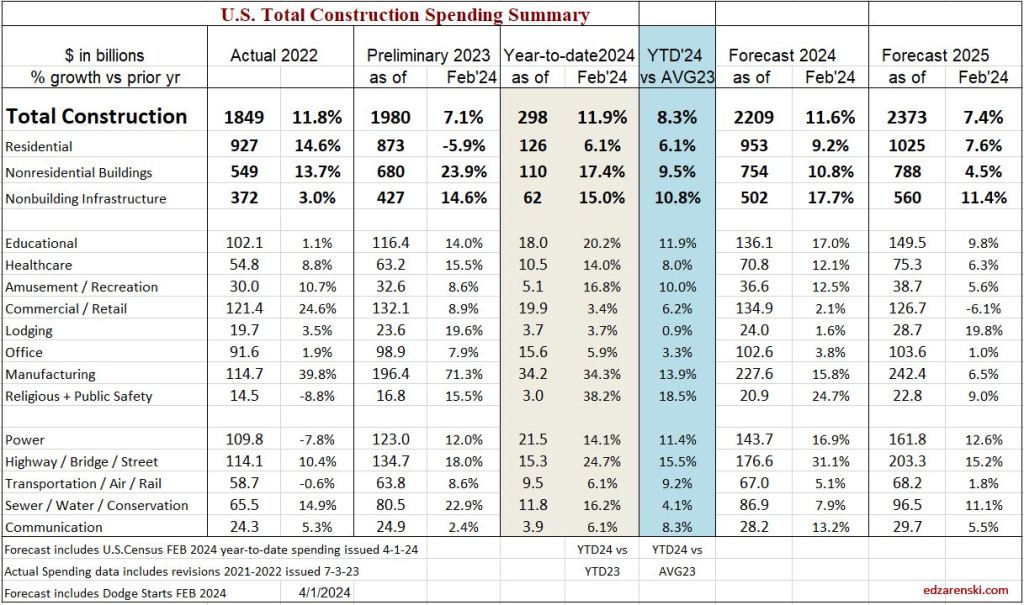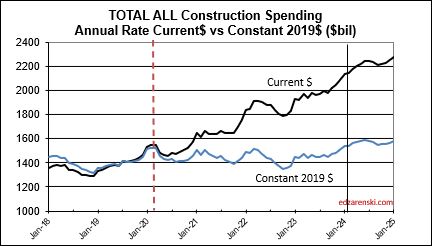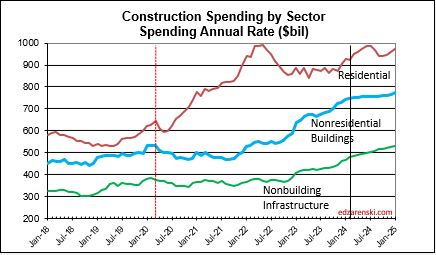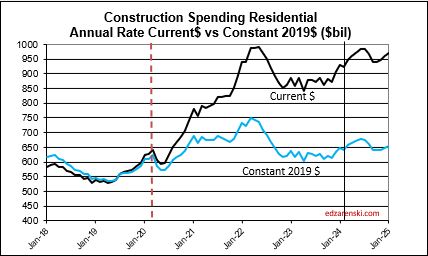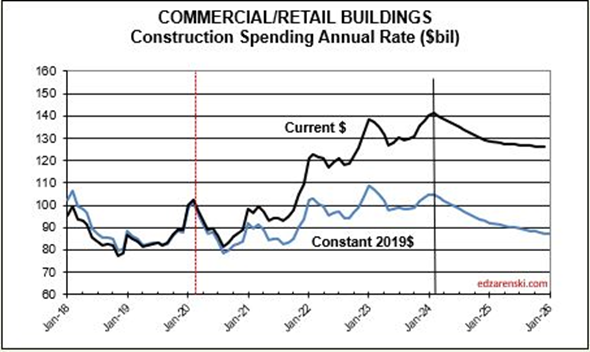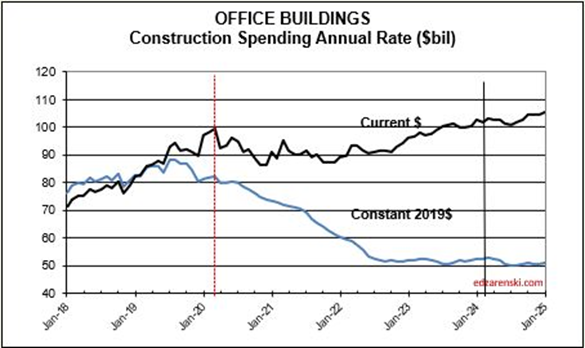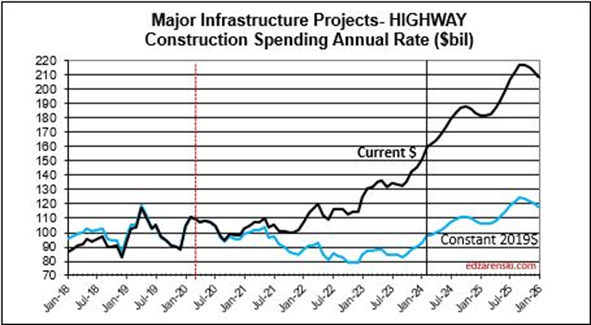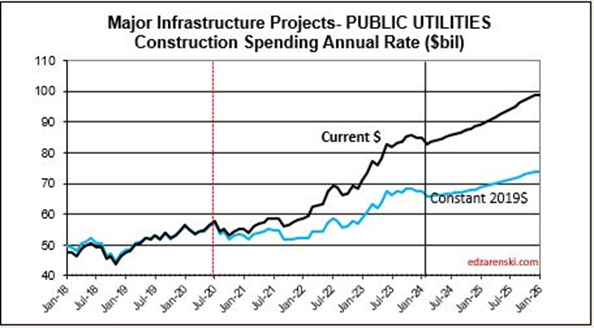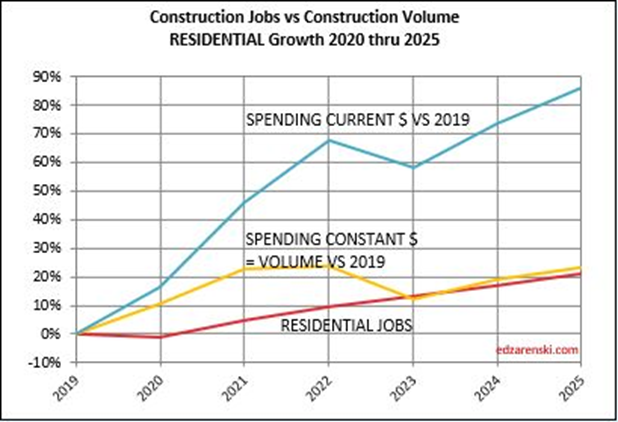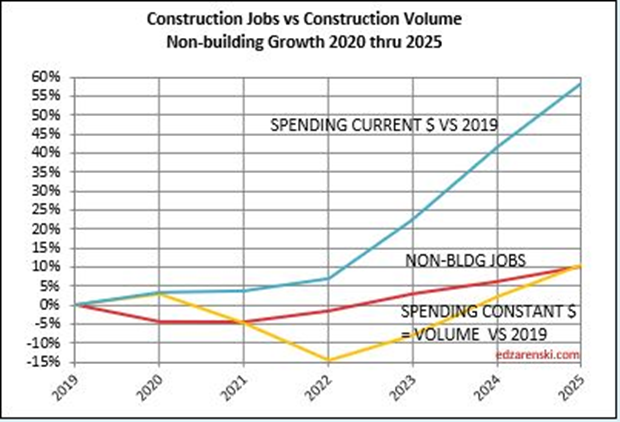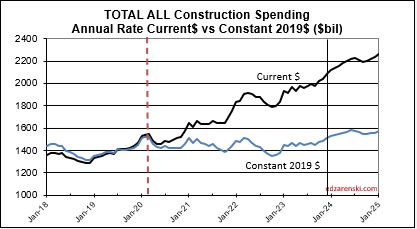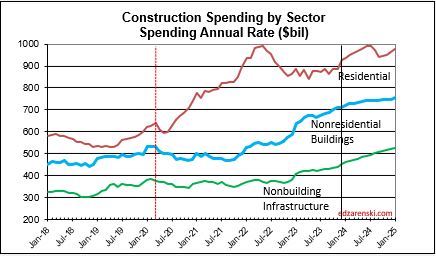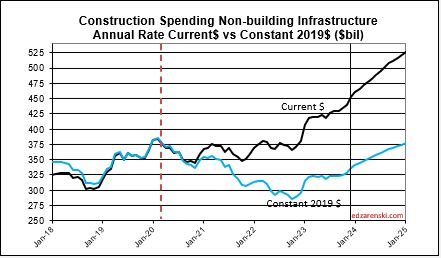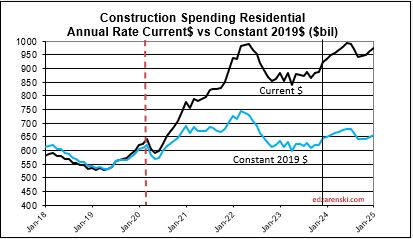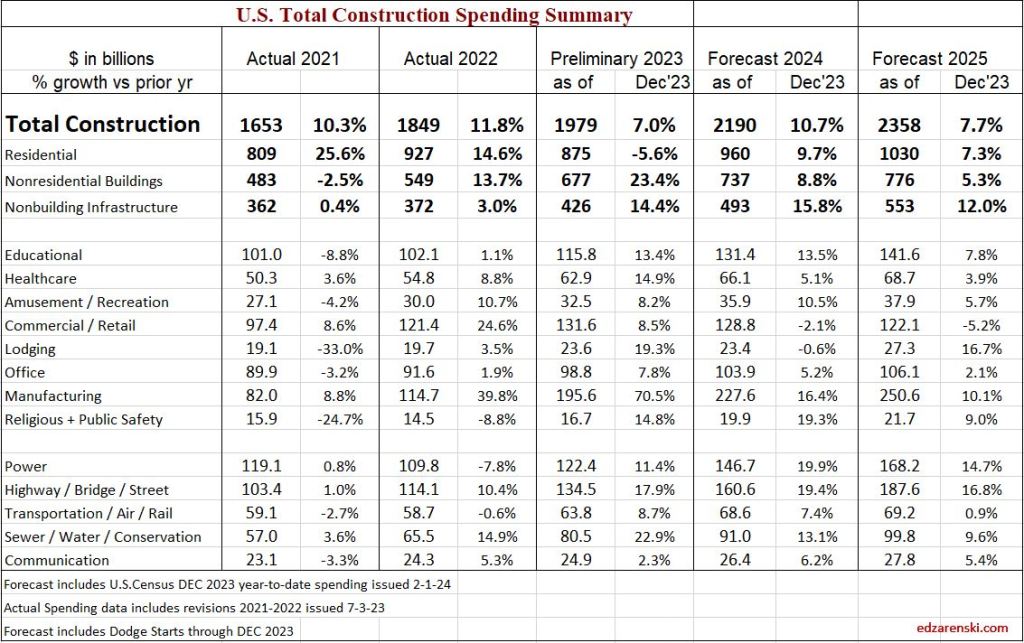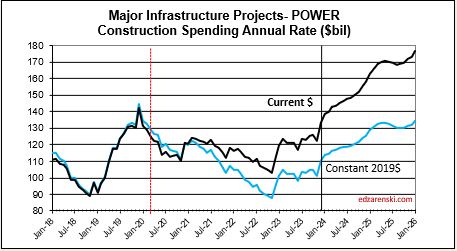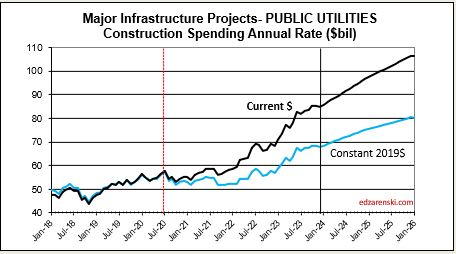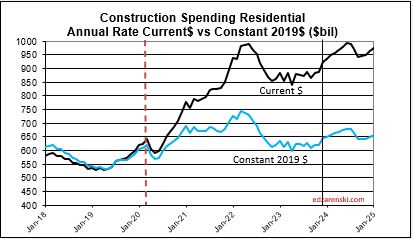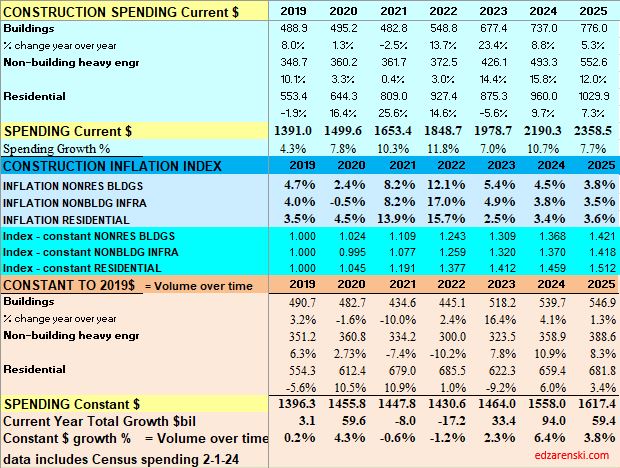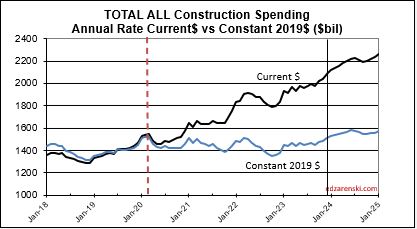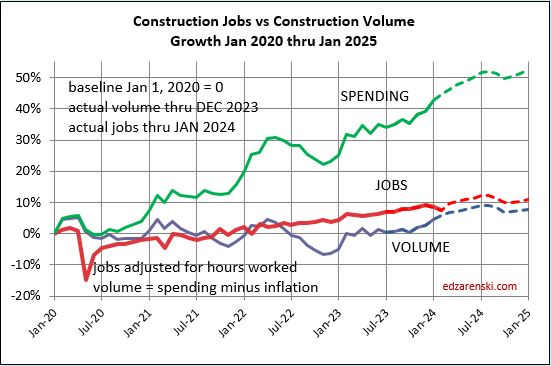Home » Backlog
Category Archives: Backlog
Construction Data FEB Briefs 4-3-24
Updates to Forecast, spending, starts, inflation, jobs
SEE ALSO Construction Analytics Outlook 2024
2024 construction spending will be measured to the avg of 2023, $1980 bil. The average Seasonally Adjusted Annual Rate (SAAR) for 2023 is the total spending for 2023. By Dec the SAAR was already 6% higher than the average for 2023. So we begin 2024 with Dec spending at a SAAR 6% above avg 2023.
As of Feb, the SAAR is 8.3% above 2023. Rsdn +6.1%, Nonres Bldgs +9.5%, Nonbldg +10.8%. If growth stalls here for the year, if we were to end the year with the SAAR unchanged from today, then we would finish with these gains for 2024. The trend in most cases is up, so I expect end of year we will be higher than today..
2024 construction spending, as of FEB, measured to the 2023 avg for Nonres Bldgs, is now +9.5% and trending up. The American Institute of Architects (AIA) Consensus for Nonres Bldgs averages +4%. Only one of the 10 forecasts for Nonres Bldgs spending in the AIA 2024 Consensus is still above the current reading.
The trend in Nonres Bldgs construction spending is up 17 of the last 18 months and continues up 9 of the 10 remaining months in 2024. To come close to most of the forecasts in the AIA, Nonres Bldgs spending for next 10 months of 2024 would need to decline drastically. To fall to the AIA Consensus average of +4% from the current SAAR, up +9.5%, all of the remaining 10 months of 2024 would need to fall from +9.5% to only +3% higher than 2023. Unless something sets off a recession, that will not happen.
Since 2019, spending is up 42%. But after inflation Volume is up only 5%. Almost 90% of the spending growth since 2019 is inflation.
Construction Backlog, the amount of work under contract that is yet to be put-in-place, increased 9% to begin 2024. Nonres Bldgs and Nonbldg both increased over 11%. Although spending is at an all-time high, backlog increases if new starts exceed spending for the year. That could happen if spending decreased, but that is not the case here. It shouldn’t come as a surprise, but manufacturing construction backlog to begin 2024 is up 21%. Highway is up 15%. Environ Pub Works is up 14%.
Don’t try to correlate my Backlog calculation to the Associated Builders and Contractors (ABC) Backlog Indicator. They do not measure the same thing. ABC BI measures current backlog as a percent of previous fiscal year revenues, then multiplies that x12 to get what they refer to as the current remaining backlog months of support. I measure the backlog as the value under contract remaining to be completed at the start of this year compared to the backlog at the start of last year.
Neither of these give any indication of WHEN backlog gets spent. Backlog is never an indication of the amount of work to be completed in the given year. Some backlog gets spent over long duration projects that may go yet for several years.
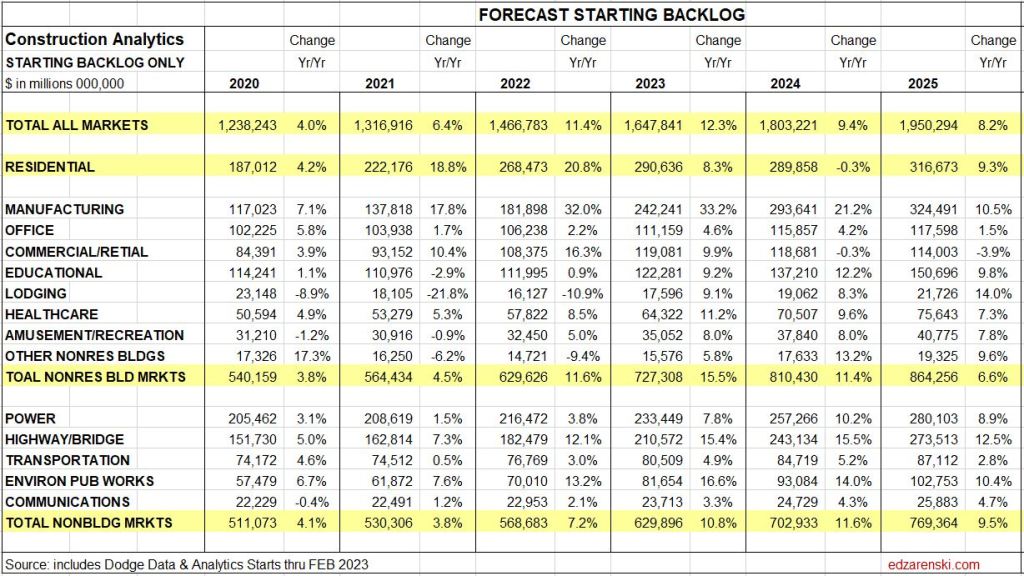
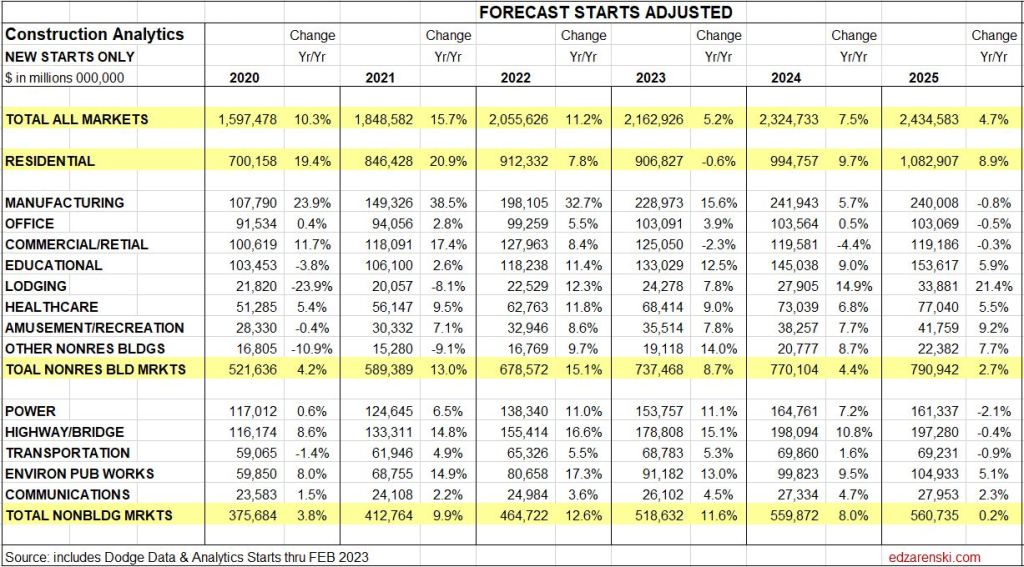
An avg spending curve for long-duration Non-bldg Infra is 15:30:30:20:5. The greatest spending impact does not show up until year two and three. Example: If 2024 posts $100bil in new starts for Infrastructure, only $15bil of that gets put-in-place in 2024. $30bil would get put-in-place in 2025 and 2026.
Manufacturing construction spending increased 80% in the last 18 months. After inflation volume increased 70%. Mnfg is 30% of all Nonres Bldgs spending, but generated 60% of the increase in Nonres Bldgs spending over the last 18 months.
In my forecast, every major sector ticks up each of next 3mo. All markets tick up each of Feb-Mar-Apr, except for Commercial/Retail. Warehouse starts, which comprise 60% of Comm/Rtl, fell 20% in 2023 and are forecast down 10%+ in 2024.
Looking at the Office Bldgs plot, keep in mind, the Office Bldg market includes Data Centers, where spending has increased.
In the past 18 months, Nonresidential Buildings construction spending increased 37%. Nonres Bldgs JOBS increased only 7%. Normally, this would be explained by inflation, but in this case after adjusting for inflation volume still increased 28%. 18 months, +28% volume, +7% jobs.
Jobs and volume of work should be moving together, evenly. The construction industry has been saying jobs shortages, and yet over an 18mo period, the nonresidential bldgs sector added 20% more volume of work than added jobs. Seems to me that would indicate that volume was absorbed by existing jobs.
In 2023 Nonresidential Building construction jobs increased 3.6%. In that same time Nonres Bldgs spending increased 24%. After inflation volume of business increased 17%. I wouldn’t be surprised if construction job openings remain elevated all through 2024.
Since 2016, construction spending has increased 63%, but after inflation, business volume increased only 1%/yr. From 2016 to 2023, jobs increased 2.5%/yr. Volume and jobs should be moving together.
In 2024, construction volume may increase 7%.
Construction Jobs increased every month since last Mar. In fact, there’s been only 2 down months in last 2 yrs. But in both Dec and Jan, avg hrs worked fell more than jobs added, so total hrs worked declined. Overall avg hrs worked for 2023 is up 4%. Volume is increasing.
Construction Analytics Outlook 2024
Construction Analytics Economic Outlook 2024 includes Construction Data – DEC 2023 Data 2-7-24
2-22-24 At the bottom of this article is a downloadable PDF of the complete 2024 Outlook
Here is a summary of construction spending through December 2023, Inflation through 4th qtr. or Nov where available, and resulting constant dollar volume. 2023 spending will be revised three times in 2024, Mar1, Apr1 and Jul1, and then again on Jul1 2025. Historically, almost all revisions are up.
Construction spending preliminary total for 2023 is up 7.0%. But nearly 80% of that total is inflation. Except for Nonresidential Bldgs, spending increased 23%, so inflation is only 25% of that. Even deducting inflation still leaves 75% of spending as volume growth Most of that growth is in Manufacturing buildings.
Spending is up a total of 42% since 2019; up 8% in 2020, 10% in 2021, 12% in 2022 and now 7% in 2023. But volume after adjusting for inflation is up only 5% total. You can see the Constant$ line, with one lower dip in 2022, has ranged between Constant$1400bil. to $1500bil. since mid-2019.
Construction spending total forecast for 2024 is up 10.7%. Nonresidential Buildings is forecast up 8.8%, Non-building Infrastructure up 15.8% and Residential up 9.7%. Lower inflation in 2024 means more of that spending is counting towards real volume growth. I’m expecting only 4% to 5% inflation for 2024, so real volume growth could reach 6% for the first time since 2015. From 2012-2016, volume growth averaged 6%/yr. For the last four years, 2020-2023, 42% spending growth vs 37% inflation growth netted only 5% total real volume growth. Since 2017, volume growth averaged less than 1%/yr. Non-building Infrastructure volume could increase 10%+ in 2024.
New Construction Starts
Dodge Construction Network (DNC) monthly news article of construction starts by sector provides the data from which the following is summarized.
Total construction starts for 2023 ended down 4%, but Nonresidential Buildings starts finished down 7% and Non-building Infrastructure starts were UP 16%. Residential starts decreased 12% in 2023.
Total construction starts for 2024 are forecast up 7%. Nonresidential Buildings starts are forecast up 5% and Non-building Infrastructure starts up 8%. Residential starts are forecast up 10% in 2024.
In recent years, Nonres Bldgs new starts averaged $300 billion/year. In the 2nd half of 2022, starts averaged near $500 billion/year. For the 1st half 2023 starts dropped to a rate of $390bil./yr., which is still well above the recent average. Then, for 2nd half 2023, starts came back up to average $430 billion/year, the 2nd highest half year average. A 50% increase in new nonresidential building starts in 2022 has a positive impact on the rate of construction spending in 2023 and 2024. It will continue to add lesser impact into 2025. Projects starting in 2nd half of 2023 could have midpoint of construction, point of peak spending, in 2024 or into 2nd half of 2025, some real long duration starts even later. So, the major spending impact from starts is sometimes one or two years later.
Residential construction (Dodge) starts posted the five highest months ever, all in the 1st 6 months of 2022. In the second half of 2022, residential starts fell 15%. In Q1 2023, residential starts dropped another 12% below 2nd half 2022, the lowest average since Q1-Q2 2020. Finally in July and August, starts regained some strength coming in 33% higher than the lows in Q1. Residential starts finish 2023 down 12% vs 2022. Forecast is up about 10% in 2024.
Nonresidential Buildings, in 2022 posted the largest ever one-year increase in construction starts, up 50%. Some of these starts will be adding to peak spending well into 2025. Nonres Bldgs starts in the 2nd half 2022, averaged 67% higher than any other 6mo period in history. Starts fell 20% in the 1st half 2023 but still posted the 2nd highest 6mo average ever. After two years of outstanding growth, Nonres Bldgs starts close 2023 down 7%. Although 2023 is down 7%, that’s still by far the 2nd best year ever. The forecast for 2024 is +5%.
Manufacturing starts, the market with the largest movement, gained 120% from 2020 to 2023. Manufacturing projects can have a moderately long average duration because some of these are multi-billion$ projects and can have schedules that are 4 to 5 years.
Educational, Healthcare, Lodging and Public Buildings all had starts of 20% or more the last two years.
Non-building starts for the 6 month period Mar-Aug 2023 posted the best 6 months on record, up 30% from the average of 2022. The 2nd half 2022 was up 50% over 1st half 2022. For 2023, Highway/Bridge and Power have the strongest gains. Total Non-building Starts for 2023 are up 16% and they were up 25% in 2022. These starts will help elevate spending through 2025. Non-building starts for 2024 are forecast up 8%.
Power starts are up 25% the last two years. Highway starts and Environmental Public Works are both up 33% the last two years and up 50% the last three years.
Starts data captures a share of the total market or only a portion of all construction spending, on average about 60% of all construction. The easiest way to understand this is to compare total annual construction starts to total annual spending. National starts in recent years about $800 billion/year, while spending in this period ranges from $1,300 billion/year to $1,500 billion/year. From this simple comparison we can see starts captures a share of about 60% of the total market. The actual share for each market varies from as low as 35% to as high as 70%. Before using starts data to forecast spending, starts here were first adjusted for market share.
Starting Backlog
Starting backlog is the estimate to complete (in this analysis taken at Jan 1) for all projects currently under contract. The last time starting backlog decreased was 2011. If new construction starts in the year are greater than construction spending in the year, then for the following year starting backlog increases. It’s when new starts don’t replenish the amount of spending in the year that backlog declines.
80% of all nonresidential spending in any given year is from backlog and could be supported by projects that started last year or 2 to 4 years ago. Residential spending is far more dependent on new starts than backlog. Only about 30% of residential spending comes from backlog and 70% from new starts.
The table below, Forecast Starting Backlog, is model generated by Construction Analytics. Adjusted starts are spread over time to generate cash flow. A sum of spending each month/year, subtracted from start of year plus new starts provides Backlog.
Construction Backlog leading into 2024, in every sector, is at all-time high, in total up 46% from Jan 2020. For the years 2022 and 2023, backlog is up 11% and 12%. Reaching new highs in Backlog could mean contractors are comfortable adding some backlog, or it could mean not enough labor, subcontractors or suppliers to support advancing growth so quickly, so growth advances slower and more of the work is retained in backlog for longer, essentially dragging out the timeline, or it could be long term workload, 4yr.-6yr. long projects from new starts, such as Manufacturing, where a very large amount enters backlog and gets spent over 4-6yrs., so, although the monthly drawdowns reduce the amount remaining in backlog, it remains in backlog for a long time.
Residential backlog in 2024 is down 0.5%, but from such a previous high, essentially, starts are riding flat along the top. Starts are up 55% since Jan 2020.
Nonresidential Bldgs starting backlog for 2024 received a boost from all the starts in 2022 and 2023. Backlog is up 12% from 2023 and up 50% from Jan 2020.
Nonbuilding Infrastructure starting backlog is up 12% each of the last two years boosted by strong starts in 2022 and 2023. For 2024, backlog is up 40% from Jan 2020.
Manufacturing backlog increased nearly 300% from 2020-2024, from $117bil going into 2020 to $300bil beginning 2024. No other market has ever been close. Manufacturing was responsible for 60% of all the Nonres Bldgs spending growth in 2023. It was also responsible for 60% of the Backlog growth leading into 2024. Nonres Bldgs has a total 3.6 million jobs and has never increased by more than 150,000 jobs in one year. Manufacturing is 30% of all Nonres Bldgs spending, so assume 30% of Nonres Bldgs jobs. That’s 1.2million jobs supporting just Manufacturing projects. So Backlog of $300bil, at 5000 jobs per billion per year, would need 1,500,000 jobs for a year. With a 1,200,000 jobs share of the workforce, that backlog would provide support for 15 months. Of course, new starts add to support throughout the year, but the calculation of how long backlog would support that market segment is valuable.
Backlog at the beginning of the year or new starts within the year does not give an indication of what direction spending will take within the year. Backlog is increasing if new starts during the year is greater than spending during the year. An increase in backlog could immediately increase the level of monthly spending activity, or it could maintain a level rate of market activity, but spread over a longer duration. In this case, there is some of both in the forecast. It takes several years for all the starts in a year to be completed. Cash flow shows the spending over time.
Current Rate of Spending
The current seasonally adjusted annual rate (SAAR) of spending gives an indication of how spending will perform in the following year. As we begin 2024, the current rate of spending (SAAR) for Nonresidential Buildings in Q4’23 is $709bil., already 4.5% higher than the average for 2023 ($677bil). If spending stays at the current level and no additional growth occurs, Nonresidential Bldgs spending will finish 2024 up 4.5%. Spending would need to have more monthly declines than increases to finish the year up less than 4.5%. The current forecast shows a monthly SAAR rate of growth for Nonresidential Bldgs. averaging about 0.5%/mo in 2024, so we have a minimum, but we can expect 2024 total spending to rise considerably higher than the current rate.
Non-building Infrastructure current rate of spending is now 3.7% higher than the average for 2023, however the forecast is indicating steady growth of 1%/mo for all of 2024.
Residential current rate of spending is 2.4% above the 2023 average and is forecast to average an increase of just under 1%/mo for 2024.
2024 Construction Spending Forecast
Starts lead to spending, but that spending is spread out over time. Starts represent a contract award. Spending takes the amount of that contract award and spreads it out by a cash flow curve over the duration of the job. An average spending curve for the sum of nonresidential buildings is 20:50:30 over three years. Only about 20% of new starts gets spent in the year started. 50% gets spent in the next year and 30% in YR3/4. An average spending curve for Non-building Infrastructure is more like 15:30:30:20:5. The effect of new starts does not show up in spending immediately. For example: If 2024 posts an additional $100 billion in new starts for Infrastructure, only about $15 billion of that would get put-in-place in 2024. The cash flow schedule for that $100 bil of new starts would extend out over 3 to 5 years. Most of that $100 bil would get spent in 2025 and 2026.
Total Construction Spending $2,190 billion +10.7% over 2023.
Nonresidential Buildings $737 billion +8.8% over 2023.
Non-building Infrastructure $493 billion +15.8% over 2023.
Residential Buildings $960 billion +9.7% over 2023.
This forecast does not include a recession.
The largest increases to construction spending in 2023 are Manufacturing +$80bil, Highway +$20bil, Public Utilities (Sewage and Waste, Water Supply and Conservation-Rivers-Dams) +$15bil and Educational +$14bil.
Residential regains the top growth spot in 2024 with a forecast spending increase of +$68bil. Manufacturing is forecast to add +$32bil. Highway gains +$26bil, Power +$24bil and Educational gains +$15bil.
One big question is how did the forecast for Manufacturing increase so much since the beginning of 2023. Since January 2023, the starts forecast for 2023 increased by 35%. How much of that 35% is real growth in starts vs an increase in the capture rate of data gathering is yet to be determined, but has an impact of 2023-2024 spending. Also, starts for future years were increased by 50%. Starts (contract awards) drives up the spending forecast, since spending is a function of the future monthly cash flow (spending) of starts.
As we begin the year, Manufacturing SAAR current rate of spending is already 8% higher than the average for 2023. The current rate of spending is increasing at an average of near 2%/month for the next 6 months, then slows or dips slightly for the remainder of the year, indicating total spending for 2024 will finish well above the current rate of 8%. I’m forecasting 16% growth for the year.
Highway SAAR rate of spending begins the year 6.5% higher than the average for 2023, with the current rate increasing at an average of 1%/month for all of 2024, indicating total spending for 2024 will finish well above the current rate of 6.5%. Starts have increased +15%/yr the last three years. My forecast is for 19% growth in 2024 spending.
Power SAAR rate of spending begins the year 4% higher than the average for 2023, with the current rate increasing at an average over 1%/month for 2024, indicating total spending for 2024 will finish much higher. My forecast is for 20% growth in 2024.
Public Utilities SAAR rate of spending begins the year 6% higher than the average for 2023, with the current rate increasing at an average over 1%/month for 2024. Public Works averaged +15%/yr new starts the last three years. My forecast is for 13% spending growth in 2024.
Residential regains the top spot in 2024 with a forecast spending increase of $68bil. Residential SAAR rate of spending in Q4’23 was up 2.5% over 2023, but December was up 5%. So we begin the year 2.5% to 5% higher than the average for 2023. The rate of spending is forecast to increase 1%/month for 6 months, then fall 0.5%/mo for H2 2024. My forecast is for 10% growth in 2024.
Educational SAAR rate of spending begins 2024 7% higher than the average for 2023, and the current rate is increasing at an average of 0.7%/month for 2024. My forecast is for 13% growth.
Inflation
Construction Inflation differs from other common types of inflation, i.e., Consumer Price Index. It must be accounted for in order to make reasonable calculations for business volume and past or future costs.
30-year average inflation rate for residential and nonresidential buildings is 3.7%. Excluding deflation in recession years 2008-2010, for nonresidential buildings is 4.2% and for residential is 4.6%.
Deflation is not likely. Only twice in 50 years have we experienced construction cost deflation, the recession years of 2009 and 2010. That was at a time when business volume dropped 33% and jobs fell 30%. During two years of the pandemic recession, volume reached a low down 8% and jobs dropped a total 14%.But we gained back far more jobs than volume. That means it now takes more jobs to put-in-pace volume of work. That increases inflation.
The following Construction Inflation plot (for Nonresidential Buildings only) shows three elements: 1) a solid grey bar reflecting the max and min of the 10 indices I track in my weighted average inflation index, 2) a solid black line indicating the weighted average of those 10 indices, and 3) a dotted red line showing the Engineering News Record Building Cost Index (ENR BCI). Notice the ENR BCI is almost always the lowest, or one of the lowest, indices. ENR BCI, along with R S Means Index, unlike final cost indices, do not include margins or productivity changes and in the case of ENR BCI has very limited materials and labor inputs.
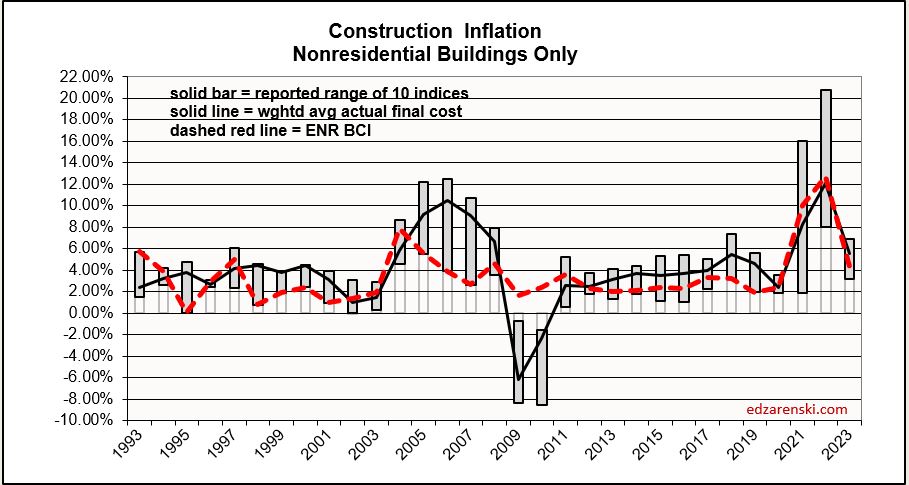
Final cost indices represent total actual cost to the owner and are generally higher than general indices. Producer Price Index (PPI) INPUTS to construction reflect costs at various stages of material production, generally do not represent final cost of materials to the jobsite and do not include labor, productivity or margins. Even with that, a PPI Inputs index +20% for a material could be only a +5% final cost. PPI Final Demand indices include all costs and do represent actual final cost. The solid black line (above) represents the Construction Analytics Building Cost Index for Nonresidential Bldgs and is a final cost index.

This short table shows the inflation rate for each year. Useful to compare to last year, but you would need to mathematically do the compounding to move over several years. The plot below shows the cumulative inflation index, or the cumulative compounded effect of inflation for any two points in time.
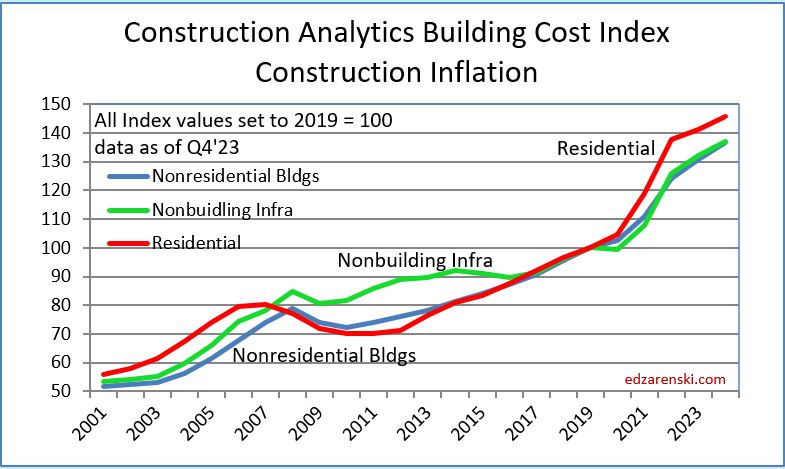
Typically, when work volume decreases, the bidding environment gets more competitive. We can always expect some margin decline when there are fewer nonresidential projects to bid on, which typically results in sharper pencils. However, when labor or materials shortages develop or productivity declines, that causes inflation to increase. We can also expect cost increases due to project time extensions or potential overtime to meet a fixed end-date.
Current$ Spending, Inflation, Constant$ Volume
Volume = spending minus inflation. Spending includes inflation. Inflation adds nothing to the volume.
Inflation adjusted volume is spending minus inflation, or to be more accurate, spending divided by (1+inflation). Inflation adds nothing to volume growth. The following table shows spending, inflation and volume (spending without inflation) for each year. Spending is current to the year stated. The values in the constant table are indexed to a constant value year, 2019. This shows business volume year to year, can be a lot different than spending would indicate. When inflation is positive, volume is always less than spending by the amount attributed to inflation.
Lower inflation in 2024 means more of that spending is counting towards real volume growth. Expecting only 4% to 5% inflation for 2024, real volume growth could reach 6% for the first time since 2015. From 2012-2016, volume growth averaged 6%/yr. For the last four years, 2020-2023, 42% spending growth vs 37% inflation growth netted only 5% total real volume growth. Since 2017, volume growth averaged less than 1%/yr. Non-building Infrastructure volume could increase 10%+ in 2024.
Spending during the year is the value of business volume plus the inflation on that volume. When inflation is 12%, volume plus 12% = total spending. Revenue is generally measured by spending put-in-place during the year. Revenue does not measure volume growth. In 2022, Nonresidential buildings inflation was 12%, so business volume was 12% less than spending, or 12% less than revenue. Residential volume was 15% less then spending.
When referencing Constant $ growth, remember the dollars for all years are reported here as 2019$. If the baseline year is changed to this year (divide all indices by this year’s index), the resulting comparison would be all years reported as 2024$. The dollars would all be greater, but the percent change would be the same. In this table, nominal spending is divided by the inflation INDEX for the year. You can also deduct the percent inflation from any individual year of spending to find inflation adjusted $ for that year alone, however that method would not allow comparing the adjusted dollars to any other year. A baseline year is necessary to compare dollars from any year to any other year.
Reference Inflation Data Construction Inflation 2024
Through December 2023, Total Construction Spending is up 40% for the four years 2020-2023, but, during that same period inflation increased 35%. After adjusting for 35% inflation, constant $ volume is up only 5%. So, while the current $ spending plot shows a four-year total increase of 40% in spending, the actual change in business volume is up only 5% and has just in the last few months returned to the pre-pandemic peak in Feb-Mar 2020.
Jobs are supported by growth in construction volume, spending minus inflation. If volume is declining, there is no support to increase jobs. Although total volume for 2023 is up 2.3%, Residential volume is down 9%, Nonresidential Bldgs volume is up 16% and Non-building volume is up 8%. Inflation was so high in 2021 and 2022 that it ate away most of the spending gains in those years.
Jobs vs Volume
Construction Jobs increased 2.75% in 2023. We added 214,000 jobs (avg’23-avg’22). There are currently 8,056,000 construction jobs. The largest annual increase post 2010 is 321,000 jobs (+4.6%) in 2018. The average jobs growth post 2010 is 200,000 jobs per year.
Since 2010, average jobs growth is 3%/yr. Average volume of work growth since 2010 is 2.3%/yr. This plot shows Jobs and Volume growth closely match from 2011 to 2018. With few exceptions for recession periods, this pattern can be seen throughout the historical data.
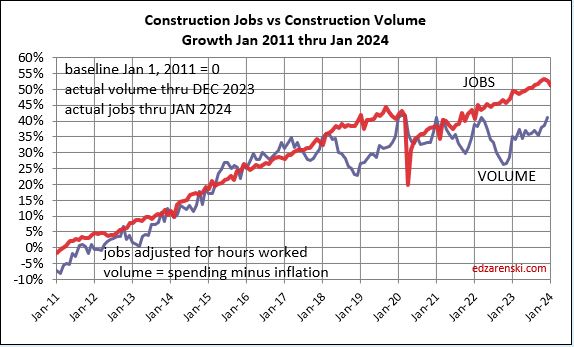
What’s remarkable about the growth is this, since 2016, spending has increased 63%, volume after inflation increased 6% and jobs increased 19%. In the last 7 years, 2017-2023, jobs increased 2.5%/yr. Volume of work increased only 0.8%/yr. Volume and jobs should be moving together.
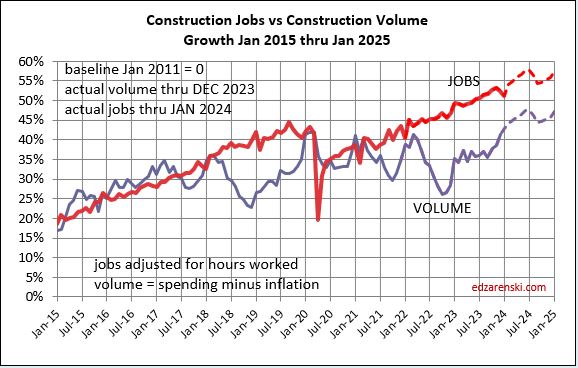
It takes about 5000 jobs to put-in-place $1 billion of volume in one year. It could easily vary from 4000 to 6000. So, an add of $100 billion+ in one year would need 500,000 new jobs. Jobs should track volume, not spending growth. Volume = spending minus inflation.
Normal construction jobs growth is about 250,000 jobs per year and maximum prior growth is about 400,000. From the table above, Nonresidential Bldgs and Non-building Infrastructure added $100bil of volume in 2023 and will add $60bil in 2024. The workload discussed above would theoretically require 500,000 new jobs in 2023 and 300,000 more in 2024. That’s an expansion of the industry workforce by 10% in two years, for just half the industry, in an industry that normally grows in total 3%/yr. This industry can’t grow that fast. This may have some impact if over-capacity growth results in a potential reduction or extension in future forecast. You can’t increase spending that fast if you can’t also expand the labor force and the suppliers to the industry that fast.
In the last 12 months, Dec’22 to Dec’23, Nonres Bldgs jobs are up 4%. Nonres Bldgs spending is up 23%, by far driven by Manufacturing, but after ~5.4% inflation, volume of nonres bldgs workload is up 16%. So, we have a 4% increase in jobs versus a 16% increase in volume.
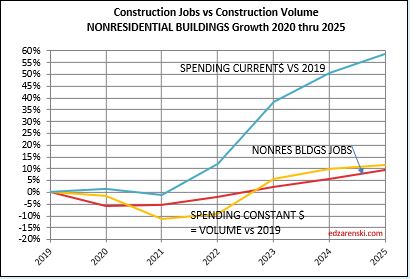
The last year has shown a huge increase in the volume of nonres bldgs work, without an equal increase in jobs. Is this excess nonres bldgs jobs for the past three years now absorbing added workload, (a 4% increase in jobs but a 16% increase in volume), without collapsing the labor force or canceling the volume?
Non-building, over the next two years, could experience the same kind of growth spurt as Nonres Bldgs., a forecast increase in volume the next two years without an equal increase in jobs. Volume which was lower than jobs since 2021, is now increasing faster than jobs. Non-bldg volume is forecast up 6% to
8%/year the next 3 years. Jobs increase at an avg. 3.5%/year.
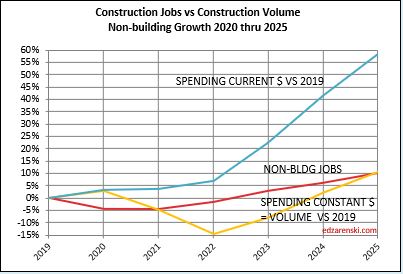
Residential volume has exceeded residential jobs all the way back to 2011. The recent decline in volume brings the two even, if the jobs hold the pace.
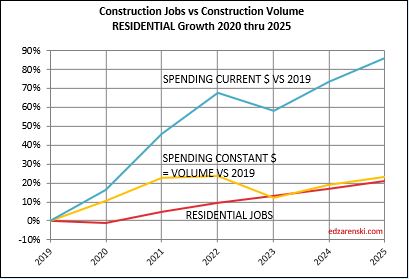
For as long as I can remember, the construction industry has been complaining of jobs shortages. And yet, as shown in the data mentioned above, jobs have increased multiples times greater than volume of work. With an exception for recession years, (2007-2010 and 2020), jobs increase at a rate of 2.5% to 3% per year. The greatest disparity between jobs and volume occurred in late 2022, when jobs growth had already resumed normal pace, but volume of work was still reeling from the effects of new construction starts that were canceled dating back to late 2020-early 2021. Recent volume growth at a much faster rate than jobs growth is now closing the gap.
When jobs increase without an equal increase in the volume of work, productivity declines. This recent increase in volume and the projected increase in volume in 2024, several points stronger than jobs, will offset some of the disparity which has been negative for a long time.
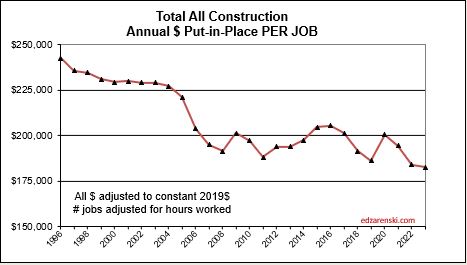
Reference Inflation Data Construction Inflation 2024
Reference Article The Next Forecast Challenge
Reference Article Midyear ’23 Jobs Outlook
Reference Article Reliability of Predicted Forecast
Reference Link to Web Dodge Construction News
Below is a downloadable 24 page PDF of the complete 2024 Outlook
ABI – DMI – CBI Leading Indicators
The American Institute of Architects Architectural Billings Index
The Dodge Momentum Index
The Associated Builders and Contractors Construction Backlog Indicator
These three construction leading indicators are often referenced. Do you reference any of these indices? Do you know what the index represents?
The American Institute of Architects Architectural Billings Index, ABI, is a diffusion index, measuring work on architectural firms’ drawing boards, measured as above 50 if increasing and below 50 if decreasing. The index is comprised of survey responses from firms representing 45% institutional work, 40% commercial work and 15% residential work. The index is said to lead commercial construction spending by 11 months and institutional construction spending by 7 months. BUT, the correlation is this, the ABI is compared to “the percent change in year over year construction spending”.
https://content.aia.org/sites/default/files/2016-04/Designing-Construction-Future_3-14.pdf
Year over year percent change can provide skewed results. If last year construction spending was on a slow decline every month, and this year spending is level from month to month, that would show up as a continually increasing year over year percent growth. Because year over year spending percent is increasing, it could be misinterpreted that current year spending is growing, but it is flat. In another example, if last year construction spending was slowly increasing every month, and this year spending is slowly increasing every month at the same rate of growth, that would show up as no growth in year over year spending, but actual month to month spending is slowly increasing. Year over year spending can be influenced by last year activity as much as current activity and may not show the current trajectory in spending.
The Dodge Momentum Index, DMI, measures the earliest known indication of projects in planning. This includes only projects that are actually in design. The index is comprised of gathered results for nonresidential projects, excluding megaprojects and excluding manufacturing. The index is said to lead nonresidential construction spending by 12 months. However, it’s individual components could lead Institutional spending by 15 months and Commercial spending by 7 months. We see that the ABI refers to the point in time when the project is already under design and that leads spending by 7 to 11 months. It would be expected that the Dodge index has a longer lead time. As an indicator of early planning Dodge excludes projects that are about to go out to bid, preserving the intent of a leading indicator.
https://www.construction.com/download/Dodge_Momentum_Index_WhitePaper.pdf
The Associated Builders and Contractors Construction Backlog Indicator, CBI, attempts to measure the work in backlog, or growth in the value of work on contractor’s books. It measures the current month of total remaining value of projects in backlog divided by the previous fiscal 12 months total revenues, times 12. The resulting output is reported in months of current backlog. Of course, projects have varied schedules to completion that may take many more months if not years to complete, so contractors may not run out of work in the few months indicated by the CBI. This index also may be influenced by something that occurred a year ago that may not reflect the current activity. What this index really measures is the current backlog as a percentage of previous fiscal year revenues, just skip the part that multiplies that percent time 12. It provides no indication of expected annual revenues.
https://abc.org/Portals/1/CEU/ABC%20CBI%20and%20CCI%20Methodology.pdf
Construction Starts – A Leading Indicator to Spending
Construction starts, although a general indicator that construction spending may be poised to grow (or fall), can also be misinterpreted. Construction starts refers to a total project value at a point in time, the contract award or the start date. For nonresidential construction, all projects that started prior to the beginning of a year will account for at least 80% of all spending within that upcoming year. Construction spending is that total project value spread out over the project scheduled duration from start to finish. Building construction spending peaks at 50% to 60% into the schedule.
Construction starts may be increasing, but rather than resulting in increased monthly spending, those starts may represent longer duration contracts. Increases in new starts does not always indicate an increase of monthly spending, but may instead represent lower monthly spending for a longer duration into the future.
All of these indices do not correlate directly to construction spending. To forecast construction spending, a cash flow schedule of all construction starts must be prepared. In any given month, spending on construction includes some monthly portion of spending from all projects that started in all previous months but that have not yet reached completion. A cash flow schedule of all monthly construction starts is the best indicator that directly forecasts construction spending.
Construction Analytics prepares estimated cash flow schedules from Dodge monthly reports of new construction starts and exclusively uses cash flow to forecast future construction spending. The cash flow schedule also allows to directly calculate the estimate to complete backlog in current $.
Know what an index represents before you put all your faith in following that index to develop your forecast.
Public/Private Construction Spending Forecast 2020-2021
12-18-20
Public Starts and Backlog
Leading into 2020, the Public markets with the highest growth in new starts the previous two years were Transportation and Public Works. Transportation terminals and rail starts were up 15% over two years, 25% in the last three years. Backlog nearly doubled in three years because a large portion of those starts is very long duration projects. Public works starts were up 13%, 20% in three years, and backlog is up 40%. Infrastructure projects typically have the longest duration. Projects contribute spending sometimes up to 5 or 6 years.
Public work backlog leading into 2020 was up an average 8%/year for the last three years. Some of this is very long-term work that started construction in 2017 and it will still contribute spending for the next several years. 40% of all public spending in 2020 comes from projects that started prior to Jan 2019.
2020 losses in new construction starts impact the forecast for the next few years. Total new starts in 2020 for Public work dropped 9%. Transportation starts fell 20%, Educational starts fell 11% and Public works fell 6%. Amusement/Recreation starts fell 40%. Highway/Bridge starts increased 4%.
2021 Starting Backlog for all Public work is down 5%. Backlog for Transportation projects drops only 4%, and that leaves 2021 still 2nd only to the all-time high in 2020. Both Educational and Public Works backlogs drop 7%. Amusement/Recreation backlog falls 40%. Highway backlog increases 3%. Of all public work in backlog at the start of 2021, 43% comes from projects that started prior to Jan 2020.
Public Spending
The two largest markets contributing to public spending are Highway/Bridge (30% of total public spending) and Educational (25%), together accounting for 55% of all public construction spending. At #3, Transportation is only 12% of public spending. Environmental Public Works combined makes up 15% of public spending, but that consists of three markets, Sewage/Wastewater, Water Supply and Conservation. Office, Healthcare, Public Safety and Amusement/Recreation account for about 3% to 4% each.
Highway is 100% public and Public Works 98%. Educational is 80% public, Transportation 70%, Amusement/Rec 50% and Healthcare 20%.
Total public spending for 2020 is projected to finished up 5% at $350 billion. Spending for every major public market is projected to finish up in 2020. By far, the largest Public spending increases measured in dollars for 2020 are Educational, Transportation and Public Safety.
Total public spending in 2021 is projected to finished up 5% at $370 billion. Transportation provides most of the gains in 2021 and Public Works adds some, but this forecast may come down without support from Highway or Educational.
Public Infrastructure and Public Institutional
A bit less than 60% of all Non-building Infrastructure spending, $198 billion in 2020, is publicly funded. That public subset of work has averaged growth of $5 billion/year from 2013 through 2019, with maximum growth of $16 billion in 2019. 2020 increased only $4 billion. In 2020, Non-Building Infrastructure spending makes up about 60% of Public spending.
About 30% of all Nonresidential Buildings spending, $141 billion in 2020, is publicly funded. It’s mostly Educational. That public subset of work has averaged growth of $6 billion/year from 2013 through 2019, with maximum growth of $10 billion in 2017. 2020 increased $14 billion. In 2020, Nonresidential Buildings spending makes up about 40% of Public spending.
- Infrastructure = $349 billion, ~25% of all construction spending.
- Infrastructure is about 57% public, 43% private. In 2005 it was 70% public.
- Public Infrastructure = $198 billion. Private Infrastructure = $150 billion.
- Power and Communications are mostly privately funded infrastructure.
- Nonresidential Buildings is 30% public (mostly institutional), 70% private.
- Educational, Healthcare and Public Safety are Public Nonres Institutional Bldgs
- Public Commercial construction and Amusement/Rec. are not included.
- Public Institutional = $110 billion, mostly Education ($86b).
Public Infrastructure + Public Institutional = $308 billion, 22% of total spending.
Public Infrastructure + Institutional average growth is $12 billion/year. This subset has never exceeded $30 billion in growth in a single year. In 2019 spending increased $20 billion. With 10 months data posted, 2020 is forecast to increase $17 billion.
Although total all public spending may increase for 2021, the select group of Infrastructure + Institutional likely to be funded by an Infrastructure stimulus bill shows 2021 growth is uncertain and may remain flat.
See Also
Down the Infrastructure Rabbit Hole
Infrastructure – Ramping Up to Add $1 trillion
Pandemic Impact on Construction, Dec. 2020
12-15-20
By far the greatest impact of the pandemic on construction is the massive reduction in new nonresidential construction starts in 2020 that will reduce construction spending and jobs for at least the next two years.
In the Great Recession, beginning in Q4 2008, nonresidential buildings new construction starts fell 5%, then fell 31% in 2009 and 4% in 2010. Spending began to drop by Dec 2008, then dropped steadily for the next 24 months. Spending dropped 40% over that next two years. During that period, residential starts and spending fell 70%.
In 2020, nonresidential buildings starts fell 24%, but the six months from Apr-Sep, starts fell 33%. Starts are forecast to fall 4% in 2021. Nonres Bldgs spending began to decline in Aug, is now down 10% from Feb high and is forecast to drop steadily the next 20 months, for a total decline of 25%. This time around residential starts and spending are increasing.
The measure of decline due to Pandemic delays and shutdowns is not the difference between Q3 vs Q1 growth or spending. Nor is the impact measured by the current difference in ytd performance vs 2019. The measure of decline due to Pandemic delays and shutdowns is the difference between what was forecast for growth pre-pandemic vs actual growth.
New construction starts projected for 2020:
- Total 2020 Construction Starts now forecast down -11%, pre-pandemic forecast was up 2%
- Nonresidential buildings now down -22%, pre-pandemic forecast was up 1%
- Non-building infrastructure now down -15%, pre-pandemic was up 2%
- Residential new starts now up 1%, pre-pandemic was up 2.5%.
New starts for 2021 were originally forecast up 1.5% to 2% in all sectors. The current 2021 forecast shows residential up 4.5%, nonresidential buildings up 4.6% and non-building infrastructure up 11%. Residential is already at a new high, but nonresidential buildings and non-building infrastructure will still be lower than 2018.
Future impact from delays/cancellations and reduced starts
Total construction starts year-to-date for 10 months through October are now down only -11% from 2019 ytd. Total starts had been down -14% to -15% ytd for the previous four months. Nonresidential buildings starts are down -24% ytd and non-building infrastructure starts are down -14% ytd. Residential starts are now up ytd +2% from 2019.
The most recent four months total residential starts, Jul-Aug-Sep-Oct’20, posted the highest 4mo total since 2005. The next highest 4mo total since 2005 was for the period Nov-Dec’19-Jan-Feb’20. So, the two best 4mo periods of new residential construction starts in the last 15 years have occurred in 2020. In August, residential starts posted an all-time high. Much of the spending from these starts carries into 2021 and supports residential spending growth in 2021.
The following table shows, for each market, the current forecast for new construction starts. With exception of residential, spending in all other markets, due to longer schedules, is most affected by a decline in new starts, not in the year of the start, but in years following. Some effects of reduced starts have not even begun to show up in the data. A 20% decline in new nonresidential starts in 2020 results in a huge decline in spending and jobs in 2021-2022. Residential spending hit bottom in May 2020 and ultimately will post an increase in 2020. Nonresidential Buildings spending will not hit bottom until 2022.
Dodge updated their Outlook to show 2020 construction starts for nonresidential buildings fall on average 20%, less in some markets, but -30% to -40% in a few markets. Only warehouses is up. Non-building starts fall on average 15%. Only Highway/Bridges is up. Residential starts may post an unexpected gain in 2020 and are forecast to climb 4.5% in 2021.
Starts lead to spending, but that spending is spread out over time. An average spending curve for nonresidential buildings is 20:50:30 over three years. Only about 20% of new starts gets spent in the year they started. 50% gets spent in the next year. The effect of new starts does not show up immediately. If new nonresidential buildings starts in 2020 are down 22%, the affect that has on 2020 is reduced spending by -22% x 20% = – 4.4%. The affect it has on 2021 is -22% x 50% = -11%. In 2022-2023 the affect is -22% x 30% = -6.6%.
Many nonresidential buildings have durations that last 24 to 36 months, with peak spending 12 to 18 months from now. With the 22% drop in new starts this year, that peak spending 12 to 18 months from now will be impacted negatively. Some nonbuilding markets have project durations that go out 5 or 6 years, so the impact of a decline in 2020 starts may be felt at least until 2025.
Starting Backlog
Starting backlog is the estimate to complete (in this analysis taken at Jan 1) for all projects currently under contract. The last time starting backlog decreased was 2011.
Backlog leading into 2020 was at all-time high, up 30% in the last 4 years. Prior to the pandemic, 2020 starting backlog was forecast UP +5.5%. Due to cancelations, that has been retroactively reduced to +2.7%.
Starting backlog pre-pandemic forecast for 2021 was UP +0.3%. Due to fewer new starts in 2020, that has now been reduced to -10.6%. By far, the greatest impact is due to nonresidential buildings for which backlog declined by 17%.
If construction starts in 2020 do not outperform 2020 construction spending, then 2021 starting backlog will be lower than 2020. My current forecast (2020 starts down -10.7%) indicates 2021 starting backlog will be down by -10%. Spending declines into 2021 and remains depressed through 2023.
80% of all nonresidential spending in any given year is from backlog and could be supported by jobs that started last year or 3 to 4 years ago. Residential spending is far more dependent on new starts than backlog. Only about 30% of residential spending comes from backlog and 70% from new starts.
Some of the projects delayed or canceled started before Jan. 2020. When one of those projects is delayed, the portion of the project delayed gets shifted and remains in future backlog longer. When one of those projects is canceled, the portion of the project not yet put-in-place gets removed from 2020 and future backlog. Not only does that reduce future backlog but also that retroactively reduces the backlog that was on record at the start of 2020. Therefore, 2020 backlog is reduced by cancelations and future backlog is increased by delays, but reduced by cancellations and a loss of new construction starts.
Future impact on Backlog from delays/cancellations and reduced starts
Projects in starting backlog could have started last month or last year or several years ago. Many projects in backlog extend out several years in the schedule to support future spending. Current backlog at the start of 2020 would still contribute some spending for the next 6 years until all the projects in backlog are completed.
Total starting backlog will fall -11% for 2021 and -4% for 2022. Due to new starts declining by 22% in 2020, Nonresidential buildings backlog drops -17% for 2021 and drops -7% for 2022. For non-building infrastructure, a drop of 15% in 2020 starts results in a drop of 8.7% in 2021 starting backlog.
Reductions in starts and starting backlog lead to lower spending. Residential construction is going counter to the trend and will post positive results for new starts, backlog and spending for the next two years. Nonresidential buildings will experience the greatest reductions in new starts, backlog and spending through 2022.
The next table shows spending year-to-date (ytd) through October (released 12-1-20) along with spending forecast for the year. 2nd quarter construction spending activity low-point was down only 5.5% from the Feb peak. Construction spending through October ytd is up 4.3% with Residential ytd up almost 10%.
Almost every market has a weaker spending outlook in 2021 than in 2020, because of lower starts in 2020. Although starts are forecast down -15% to -20% in 2020 and then up +5% to +15% in 2021, the drop in starts in 2020 has the greatest impact on reducing spending in 2021. Most of the reduced spending impact from the lost starts is felt in the future, when those lost projects would have been reaching peak activity at the midpoint of construction. Nonresidential buildings starts in 2020, now down 28% the last seven months. Lowpoint of spending from lost 2020 starts is late 2021- early 2022.
Residential spending looks stable heading into 2021, Nonresidential Buildings spending drops -2% to -3% each quarter in 2021. By Q4 2021, nonresidential buildings spending is down 15% from Feb 2020. When looking at Total Construction Spending for 2021, residential growth obscures the huge declines in nonresidential.
YTD spending for Nonresidential Buildings is currently -1.2% and my 2020 forecast shows Nonres Bldgs ending the year down -2.1%. Some forecasters are predicting spending for nonresidential buildings will end the year down much worse compared to 2019. It would now be difficult to move the end-of-year forecast %change by much, with already 10 months recorded at an average of -1.2%. Also, some forecasts for 2021 predict spending for nonresidential buildings will increase. Remember, most of the reduced spending impact from the lost starts is felt when those lost projects would have been reaching peak spending.
Nonresidential Buildings construction will take several years to return to pre-pandemic levels. Although nonresidential buildings spending is forecast down only -2%, the gapping hole left by the 15%-25% drop in 2020 construction starts will mostly be noticed in 2021 spending. Project starts that were canceled, dropping out of new backlog between April and September 2020, would have had midpoints, or peak spending, April to September 2021. Nonbuilding project midpoints could be even later. The impact of reduced new starts in 2020 is reduced spending and jobs in 2021 and 2022.
Construction Jobs are projected to fall in 2021. While 2021 Residential spending will climb about 10%, Nonresidential building spending is forecast to drop -10% and Non-building spending drops -4%.
A recent AGC survey of construction firms asked, how long do you think it will be before you recover back to pre-COVID-19? The survey offered “longer than 6 months” as an answer choice. Less than 6 months was the right answer for residential, but my current forecast for full recovery of nonresidential buildings work is longer than 6 years.
2020 Construction Economic Forecast – Jan 2020
Construction Analytics 2020 Construction Economic Forecast
This January, 2020 Construction Economic Forecast addresses New Construction Starts, Inflation, Cash Flow or distribution of construction work over time, Backlog, Spending or Revenue, and Volume. New Construction Starts is new work entering Backlog. Cash Flow gives the pattern of Spending. Spending adjusted for Inflation differentiates between Revenue and Volume. Backlog can be referenced to assess expected future Volume and Spending. Cash flow provides an indication of when Volume occurs or in what year Revenues occur.
Starts data is from Dodge Data & Analytics. Spending data is from the U.S. Census Bureau. Jobs data is from the Bureau of Labor Statistics. Inflation data is from the source labeled. Cash flow, Backlog and Inflation forecast data are developed internally. All data in this report is national level data. All forecast data is by Construction Analytics
Click here for a downloadable PDF of 2020 Construction Economic Forecast Feb 2020
Click here for a downloadable PDF of SUMMARY – 2020 Construct Econ Forecast 2020
Summary of 2020 Construction Outlook
Total of All construction spending in 2019 is forecast to decrease -0.2% to $1.305 trillion. For 2020, spending increases by 4.6% to $1.365 trillion.

Nonresidential Buildings construction spending is forecast to finish 2019 at $455 billion, level with 2018. For 2020 the forecast is a gain of 3% to $467 billion. Educational and Commercial/Retail held down gains in 2019. Office (which includes data centers) and Lodging gained 7% each. Office, Healthcare and Educational all support growth in 2020.
Residential construction spending forecast is down 5% to $521 billion in 2019 and up 6% to $552 billion in 2020. New starts are recovering from a 10% drop in the 1st half of 2019 and are now expected down only slightly for 2019 after the latest three-month average starts were the highest ever. Residential spending peaked in Q1 2018 and dropped 11% to a low in July 2019. Although spending has since recovered half of that drop, growth in 2019 slowed to less than inflation. Residential construction volume in 2019 dropped 8%, the largest volume decline in 10 years. 2020 volume is forecast to increase 2%.
Non-building Infrastructure construction spending is forecast to increase 7% to $329 billion in 2019 and 5% to $345 billion in 2020. Transportation spending gets strong growth from three years of record new starts. Half of all transportation spending in 2021 comes from projects that started in 2017-2019. Both Public Works and Highway starts have been increasing modestly to reach new highs in 2019. Non-building Infrastructure projects have the highest share of multi-billion dollar projects that spread spending out over longer duration.

Spending data for the previous two years gets revised in July of the following year. Those revisions are always up, although some markets may increase while others decrease. So, even though the current forecast for 2019 spending is down -0.2% to $1.305 trillion, that will most likely increase to a net gain.
In their October annual report, Dodge Data forecast 2019 construction starts to total $809 billion, down 1% from 2018. However, starts are always revised up in the following year. In just the last three years, nonresidential starts have been revised up by 7.5%/yr and residential starts by 2.4%/yr. I expect revisions will show 2019 starts increased by 3% to 4% over 2018. However, even with revisions, 2019 starts will post the slowest annual growth since 2011.
Dodge Data and Analytics new construction starts for November 2019 advanced to the highest seasonally adjusted annual rate ever, resulting in the three months Sep-Oct-Nov 2019 posting the highest 3-mo average ever, 10% higher than the total average for 2018. Several long duration projects started, so a lot of the spending from these new starts will occur in 2021-2022. Dodge is forecasting 2020 starts down 4%. This forecast includes only 1% to 2% growth in new starts for 2021-2022.
Starting backlog, which increased 5% leading into 2020 is currently at an all-time high, up 20% since 2017. 80% of all Nonresidential spending within the year will be generated from projects in starting backlog. More than 20% of all spending in 2020 is from projects that started more than 3 years ago.
While a few markets will outperform in 2020 (transportation, public works, office), predicted cash flow (spending) from backlog is up only 1% to 2%. Long duration projects added to backlog and will spread spending out over the next few years. Current indications are that 2020 backlog will be up 4% for residential work, 6% for nonresidential buildings and 7% for infrastructure work.
- Starts increased 8%/yr. in 2016 and 2017, but only 4% in 2018.
- Starts are forecast to decline slightly in 2019 and 2020.
- Spending increased 9%/yr. from 2012 to 2016, then slowed to 4%/yr. in 2017 and 2018.
- Spending declined 1% in 2019 and is forecast up 4% for 2020 and 1% in 2021.
- Backlog reaches a post-recession high in 2020, up 20% from 2017, up 100% from 2013.
Since early 2018, jobs have been increasing while construction volume is declining. A declining volume of work does not support jobs growth. When volume of work decreases, jobs should also decrease. If jobs increase, then it results in more workers to produce the same amount of work. In other words, productivity is declining. This could result in one or more of these outcomes:
- Labor demand on hiring drives labor cost up by unexpected amounts.
- New labor coming into the workforce has less experience, lowering productivity.
- Contractors cannot meet schedules, extending project duration.
- Contractors work overtime to meet schedules, adding cost.
All scenarios either extend project duration or drive up the cost of projects or both, which could lead to some unforeseen inflation.
General construction cost indices and input price indices that don’t track whole building final cost do not capture the full cost of inflation on construction projects. Residential and Nonresidential Buildings inflation indices developed by Construction Analytics are final cost selling price indices.
Nonresidential buildings inflation, after hitting 5% in both 2018 and 2019, is forecast for the next three years to fall from 4.4% to 3.8%, lower than the 4.5% average for the last 4 years.
Residential construction inflation in 2019 was only 3.6%. However, the average inflation for six years from 2013 to 2018 was 5.5%. It peaked at 8% in 2013 but dropped to 4.3% in 2018 and only 3.6% in 2019. Forecast residential inflation for the next three years is level at 3.8%.
Non-building infrastructure indices are so unique to the type of work that individual specific infrastructure indices must be used to adjust cost of work.
This link points to comprehensive coverage of the topic inflation. Click Here for Link to a 20-year Table of 25 Indices
This link points to articles related to the Construction Outlook for 2020. Click Here for Link to Construction Economic Outlook 2020
Some Signs Ahead – Economic Indicators
The following reports can be accessed by clicking on the hyperlinks provided.
AIA Consensus January 2020 Construction Forecast is a semi-annual survey of construction economists’ projections for future nonresidential buildings spending. The January 2020 Consensus report of expectations for nonresidential construction shows predicted growth for 2020 at 1.5%. All major markets show growth expectations between -2% and +4%. Office, Healthcare and Education are projected to gain 3% to 3.9%. Commercial/Retail, Lodging and Amusement/Recreation are expected to fall 1.3%-1.9%.
Architectural Billings Index (ABI) measures monthly work on the boards in architectural
firms. It is a nine to twelve month leading indicator to construction. Index values above 50 show increasing billing revenues, and below 50 indicates declining revenues. All ABI indices were above 50 from Jan. 2017 through Jan. 2019. However, from Jan. 2018 through 2019, contrary to the index, spending posted the largest drop in six years.
Dodge Momentum Index (DMI) is a monthly measure of nonresidential projects in
planning, excluding manufacturing and infrastructure. It is a leading indicator of specific nonresidential construction spending by approximately 12 to 15 months. This plot moves the DMI ahead to show when the index would have an affect on construction spending. The DMI is indicating a slow decline in new spending for the 1st half of 2020 but then a rapid increase in the 2nd half. From July 2019 onward, the DMI does not agree with the Starts Cash Flow which is a forecast of the movement in the spending forecast.

Producer Price Index indices for 2019 materials average Inputs to construction in 2019 posted a gain of only 1.5%. up 2.1% for nonresidential buildings and up only 0.9% for residential. However, selling price indices for nonresidential buildings and nonresidential trades averages 4% with Industrial buildings, warehouses and schools all over 4.5%. The difference between these indices is the combined affect of labor cost and contractor margins which are not tracked in the PPI inputs.
FMI Q4 2019 Nonresidential Construction Index (NRCI) is 50.4, the lowest reading in eight years. The NCRI is a diffusion index based on a survey of opinions submitted by nonresidential construction executives. With only one slight bump up in Q2 2019, it dropped every other quarter since Q2 2018. Construction spending has been lower every quarter since Q2 2018. Construction spending in 2018 and 2019 declined to the two lowest years since 2011.
Institute for Supply Management (ISM) Non-Manufacturing Index (NMI) Report
for December 2019 is a better indicator of activity in the construction industry than the
ISM manufacturing report. The NMI measures economic activity in 13 industries
(including construction) not covered in the manufacturing sector. The December NMI is
55.0, above 50 for 126 consecutive months, indicating continued economic growth.
Construction shows growth in business activity and increased backlog. Construction shows slower deliveries but no change in prices paid. Construction reports contractors in short supply. A comment from a construction respondent, “While demand is outstripping supply in the housing market, business is down due to global trade insecurity causing affordability, labor and cost pressures.”
Construction Starts > Cashflow > Backlog > Spending
One of the best predictors of construction inflation is the level of activity in an area. When the activity level is low, contractors are all competing for a smaller amount of work and therefore they may reduce bids. When activity is high, there is a greater opportunity to bid on more work and bids can be higher. The level of activity has a direct impact on inflation.
Construction starts data is needed to predict spending or the level of market activity. This provides insight into market costs and inflation. To predict spending activity from new construction starts, the starts data must be spread over time using appropriate cash flow curves. On average about 20% of new construction starts gets spent within the year started, 50% is spent in the next year and 30% is spent in year three or later. Applying an expected duration for all starts depending on market type to produce a forecast cash flow from starts data, the expected pattern of spending is developed.
The starts data is a survey. As in any survey, starts data captures a share of the total market or a portion of all construction spending, on average about 60% of all construction. The easiest way to understand this is to compare total annual construction starts to total annual spending. National starts from 2016 to 2019 range from $750 billion/year to $800 billion/year, while spending in this period ranges from $1,200 billion/year to $1,300 billion/year. From this comparison we can see starts captures a share of about 60% of the total market.
This table shows Office starts in 2016 did not drive up spending in 2017, the 2nd year, when most spending occurs. Manufacturing had two huge years of growth in starts but very little growth in spending the following years. The cash flow curves for starts determine when spending occurs. The forecast shows Office spending up 9% in 2020 and Manufacturing up 10% in 2021.

All construction starts data in this report references Dodge Data & Analytics Starts Data.
Backlog at the beginning of the year or new starts within the year does not give an indication of spending within the year. New starts within any given year could contribute spending spread out over several years. Total cash flow in the year, or spending, could include cash flow from projects that started or entered backlog years ago. An increase in backlog could represent a level rate of market activity, but for a longer duration.
Cash flow provides the best indicator of how much and when spending will occur. Cash flow from all previous starts gives a prediction of how spending will change monthly from all projects in backlog. Cash flow totals of all jobs can vary considerably from month to month, are not only driven by new jobs starting but also old jobs ending, and are heavily dependent on the type, size and duration of jobs.
New Construction Starts
Total of all construction starts increased every year from 2010 through 2019. Average growth from 2012 to 2017 was 8%/year. New starts slowed to +2% in 2018 and are forecast up +1% in 2019 and +2% in 2020. Backlog is still up leading into 2020 but after that starts and backlog are forecast to remain below 2% gain or decline over the next few years. Total spending has only slight gains in 2021 and 2022.

Nonresidential Buildings starts (excluding Terminals) increased every year since 2010. Only Manufacturing declined slightly in 2017. Commercial/Retail declined 6% in 2018. Commercial, Lodging and Amusement posted declines in 2019. The last three years (adjusted) starts are up only 2% to 3% per year.
Backlog for Office Buildings and Lodging is up 100%+ since 2016. Office includes data centers. Commercial/Retail backlog is down 14% in the last two years. Spending is still up 4% in 2020 but then with the slowdown in starts forecast in 2020, backlog growth stalls and spending slows in 2021-2022.
75%-80% of all Nonresidential Buildings spending within the year will be generated from projects that were booked in starting backlog at the beginning of the year.

Non-building Infrastructure two markets with the largest share of new starts are Highway/Bridge and Transportation. Transportation terminals and rail starts are up 35% in the last three years, but backlog has doubled because a large portion of those starts is very long duration projects.

Non-building Infrastructure starts can be erratic with a long pattern of up then down years. Starts (including Terminals) gained only 4% in 2019 but are at an all-time high. Even though starts gain less than 2% in 2020, backlog peaks in 2021. Spending increases are in the 5% to 8% range at least for the next two years. Infrastructure projects typically have the longest duration. Projects contribute spending sometimes up to 5 or 6 years. Spending in recent years has been boosted by Transportation terminals and Highway projects.
Most of the residential spending in any year is cash flow from new starts. For short duration residential spending, single-family residential and renovations work, approximately 75% of spending in the year comes from project starts within the year.

For long duration residential spending, typical of multifamily residential, approximately 50%-55% of the spending occurs in the year of the start, 35%-40% in the next year and only 5%-10% occurs two years out.
- 75% to 80% of short duration Residential spending within the year will be generated from projects that are recorded as new starts within the year.
- 50% to 55% of long duration Multifamily Residential spending within the year will be generated from projects that are recorded as new starts within the year.
Dodge releases its first forecast of next year’s starts every year in the 4th quarter. Dodge initial forecast for 2019 starts was $808 billion, no change from 2018. Starts are currently at $818 billion and will be subject to more revisions.
- Previous year starts always later get revised upwards. Therefore, current year starts YTD growth is always understated. This analysis compensates for that.
- New starts will generate record high starting backlog for every sector in 2020.
Revisions for the last 8 years averaged more than +6%/yr., with most of the upward revision in nonresidential buildings. However, for the last 3 years revisions added only 4%. Revisions to nonresidential buildings have been greater than 7%/year for the last 3 years, non-building revisions average 8%/yr and residential revisions average 2.4%/yr. Therefore, 2019 starts growth is very likely under-reported.
For nonresidential buildings spending, long duration jobs can sometimes have a 5 to 6-year schedule. On average most years have at least some projects start that will be under construction for at least 4 years. For an entire year’s worth of starts, approximately 20% of the spending occurs in the year started, 50% in the next year, 25% in the third year and only 5% in the fourth year or later year. Residential starts contribute spending into the third year. This means that nonresidential spending growth in 2019 was affected by starts from 2016 and residential growth from starts in 2017. This also means that nonresidential spending growth in 2020 is still being affected by starts from 2017.
The Estimated Spending plot below is an index. The plot shows greater accuracy in the cash flow forecast when the slope of the predicted cash flow and actual spending plot lines move in the same direction at the same slope. It’s not the spread between the lines that gives any indication. If the slope of the lines is the same, then the cash flow is accurately predicting the spending.
The light green line for nonresidential buildings spending estimated from starts cash flow shows smooth spending, even though actual monthly starts can be erratic. The actual spending often follows close to the pattern estimated from cash flows.

Starts are sometimes misinterpreted in common industry forecasting articles. Starts dollar values represent a survey of about 60% of industry activity, therefore Starts dollar values cannot ever be used directly to indicate the volume of spending. Also, Starts do not directly indicate changes in spending per month or per year. Only by including an expected duration for all Starts and producing a forecast Cash Flow from Starts data can the expected pattern of spending be developed. Finally, it is the rate of change in Starts Cash Flows that gives an indication of the rate of change in spending.
Starting Backlog
Starting Backlog is the Estimate-to-Complete (ETC) value of all projects under contract at the beginning of a period. Projects in starting backlog could have started last month or last year or several years ago.
- 75%-80% of all Nonresidential Buildings spending within the year will be generated from projects in starting backlog.
- 80%-85% of all Non-Building Infrastructure spending within the year will be generated from projects in starting backlog.
- 70% of All Residential spending within the year is generated from new starts, but this is weighted because 85% of all residential work is short duration single family and renovation work.
- 65% on long duration Multifamily Residential spending within the year will be generated from projects in starting backlog.
Nonresidential Buildings starting backlog at the beginning of 2020 reached an all-time high. For purposes of this analysis, I’ve set only moderate or low increases in starts for 2020 and 2021, so this forecast may hold down the future backlog and spending forecast. However, backlog leading into 2020 is up 60% in 5 years.

Non-building Infrastructure starting backlog at the beginning of 2020, up 10% from 2019, reached an all-time high. Some of this is very long-term work that started construction in 2016-2017 and it will contribute spending for the next several years. In fact, about half of all spending in 2020 comes from projects that started prior to Jan 2019. 2021 Backlog is forecast to increase 9%. Backlog is up 25% in the last 3 years.

Residential starting backlog, unlike nonresidential, does not contribute nearly as much short-term residential spending within the year. Multifamily residential has a longer duration and a greater percentage of spending comes from backlog. But, due to the shorter duration of projects, about 75% of single family and residential renovation spending within the year is generated from new starts.

The plot below shows that backlog has been increasing since 2011-2012. Many projects in backlog extend out several years in the schedule to support future spending, so backlog growth in not an indicator that tracks directly yr/yr with spending. Without any new construction starts in 2020 or beyond, current backlog at the start of 2020 would still contribute some spending for the next 6 years until all the projects in backlog are completed.
For Nonresidential Buildings, 68% of 2020 Backlog will get spent within the 1st year. 27% of 2020 Backlog will get spent next year. 2020 backlog will last for 58 months.
For Non-building Infrastructure, 53% of 2020 Backlog will get spent within the 1st year. 32% of 2020 Backlog will get spent next year. 2020 starting backlog will last for 72 months
For Residential construction, 95% of 2020 Backlog will get spent within the 1st year. 2020 backlog would run out in 18 months. Residential construction is far more dependent on new construction starts. If no new work started, the backlog workload would run out quickly.
How much of the spending forecast is supported by starting backlog. For all construction, 62% of 2020 total spending comes from starting backlog. If no new work starts after December 2019, then only 24% of the 2021 spending forecast would be supported from 2020 starting backlog.
Cash Flow
Simply referencing total new starts or backlog does not give an indication of spending within the next calendar year. Projects, from start to completion, can have significantly different duration. Whereas a residential project may have a duration of 6 to 12 months, an office building could have a duration of 18 to 24 months and a billion-dollar infrastructure project could have a duration of 3 to 4 years. New starts within any given year could contribute spending spread out over several years. Cash flow totals of all jobs can vary considerably from month to month, are not only driven by new jobs starting but also by old jobs ending, and are heavily dependent on the type, size and duration of jobs.
Cash flow from all previous starts still in backlog plus cash flow from new starts supports a 2020 spending forecast of $1,365 billion, an increase of 4.6% over 2019. Dodge initial November 2019 forecast for construction starts in 2020 is $776 billion, down 4% from 2019. However, subsequent revisions may increase that a few percent.
There are sometimes vast differences between amounts of Starts, whether already in Backlog at beginning of year or New Starts within the year, and Cash Flow from Backlog and New Starts. The highlighted examples below, Office and Manufacturing, show starts is not a good indicator of expectation for spending.

Note that new manufacturing starts were up 29% in 2017 and 26% in 2018, yet 2019-2020 spending is forecast to increase only 3%. This is due in part to the share of market captured in the starts survey having increased, but also to very large projects that started but that have much longer than normal duration to complete, therefore moving the largest monthly cash flows further out into the future.
The following table clearly shows there is not a correlation between starts in any year with spending in either the current or the following year. The practice of using construction starts directly to predict spending can be very misleading in an industry that relies on data for predictive analysis to plan the future. Not only does it not predict the volume of spending in the following year, it does not even consistently predict the direction spending will take, up or down, in the following year. It’s a false indicator and it’s not a good use of data.

Spending
Total of All construction spending is forecast to increase 0.2% to $1.305 trillion in 2019, 4.6% to $1.365 trillion in 2020 and 0.9% to $1.377 trillion in 2021.

Construction spending is strongly influenced by the pattern of continuing or ending cash flows from the previous two to three years of construction starts. Current month/month, year/year or year-to-date trends in starts often do not indicate the immediate trend in spending.
Residential Buildings Spending
Residential construction spending is forecast down -4.6% to $521 billion in 2019, but strong new starts in Q4 increases spending by 6.0% to $552 billion in 2020. A 5% decline in 2020 new starts lowers spending in 2021 by -3.79% to $532 billion.
New starts are recovering from a 10% drop in the 1st half of 2019 and are now expected down only slightly for 2019 after the latest three-month average starts were the highest ever. Residential monthly rate of spending peaked in Q1 2018 and dropped 11% to a low in July 2019. Although spending has since recovered half of that drop, there was no overall growth in 2019.
Residential spending average growth from 2011 through 2017 was 12%/year. Although spending increased 2.7% in 2018, growth was less than inflation of 4.3%, therefore 2018 volume after inflation decline by 1.5%. In 2019 residential spending decreased 4.5%. After accounting for 3.6% inflation, real volume decreased by 7.8%. Residential construction volume in 2019 posted the largest volume decline in 10 years. 2020 volume is forecast to increase only 2%.
Single Family Residential spending is more dependent on new starts within the most recent 12 months than on backlog from previous starts. Multi-Family Residential spending is more dependent on backlog.

Total residential new starts for the last 3 months and the last 6 months posted the highest rates of growth since 2006. Growth for 2019 is initially down -2.5%, but that is because 2018 has already been revised up by 2.1% and 2019 is yet to be revised. Revisions are usually up. Dodge predicted 2019 starts would fall 5%, however my current forecast is a drop of only 1.3%. 2020 starts are forecast up 2.6%.

Residential current$ spending reached a 12-year high in 2018 of $580 billion but that was still far below the 2006 peak of $690 billion. In constant$, adjusted for inflation, all years from 1998 through 2007 were higher than 2018. In constant$, 2018 spending is still 28% below the 2005 peak. As of Dec 2019, constant$ spending is 37% below the 2005 peak.

Nonresidential Buildings Spending
Nonresidential Buildings construction spending for 2019 is forecast to finish at $455 billion, up only 0.3% from 2018. Spending is forecast to increase 2.9% to $467 billion in 2020 and 1.2% to $473 billion in 2021. Healthcare, Educational and Office (which includes data centers), support the 2020 forecast. There is downward pressure the next two years from slowdowns in Amusement/Recreation, Commercial/Retail and Lodging.

Current$ spending for Nonresidential buildings reached a monthly high of $470 billion in mid-2018 but then fell slightly and remained between $450 and $460 billion in 2019. Both 2018 and 2019 totals averaged new annual high marks just slightly above 2008. Average annual 2019 spending grew only 0.3% from 2018. 2020 is forecast up 2.9%.
Spending in constant$ (inflation adjusted $) peaked in mid-2018 at $450 billion but by Dec. 2019 it’s down 10% to only $406 billion. It’s expected to remain at this level throughout 2020. Constant $ spending or real volume growth shows all years from 1995 through 2010 had higher volume than the 2020 forecast.

Non-building Infrastructure Spending
Non-building Infrastructure construction spending is forecast to increase 6.8% to $329 billion in 2019 and 4.9% to $345 billion in 2020. Transportation spending gets strong growth from three years of record new starts. In 2017, transportation terminals increased more than 100%. Half of all transportation spending in 2021 comes from projects that started in 2017-2019. Both Public Works and Highway starts have been increasing modestly to reach new highs in 2019. Non-building Infrastructure projects have the highest share of multi-billion dollar projects that spread spending out over longer duration.
Current infrastructure backlog is at an all-time high and spending is expected to follow the increased cash flows from the elevated backlog. Transportation terminals new starts jumped 100%+ in 2017 . Starting backlog for all transportation work is the highest ever, up 100% since 2017. Transportation spending is projected to increase 20-25%/year for the next two years.

Current$ spending for Non-building Infrastructure reached a high annual rate of $340 billion in mid-2019 but then fell slightly to only $325 billion by year end. Spending in 2020 is expected to increase slowly from $330 billion to $350 billion. Total 2020 spending is expected to increase 5%.
Non-building Infrastructure construction spending in constant $ (inflation adjusted $) peaked at reached $330 billion in 2016, an all-time high, but then dropped to $280 billion in 2018. In 2020 it will average $300 billion. Constant $ spending or real volume growth dropped 10% in 2017-2018 but is forecast to gain 6% in 2019-2021.

Public Infrastructure and Public Institutional
Just 60% of all Non-building Infrastructure spending, about $194 billion, is publicly funded. That public subset of work averages growth of less than $10 billion/year.
About 30% of all Nonresidential Buildings spending, about $134 billion, is publicly funded, mostly Educational. Nonresidential buildings spending makes up just over 40% of Public spending.
- Infrastructure = $328 billion, ~25% of all construction spending.
- Infrastructure is about 60% public, 40% private. In 2005 it was 70% public.
- Public Infrastructure = $194 billion. Private Infrastructure = $134 billion.
- Power and Communications are mostly privately funded infrastructure.
- Nonresidential Buildings is 30% public (mostly institutional), 70% private.
- Educational, Healthcare and Public Safety are Public Nonres Institutional Bldgs
- Public Commercial construction is not included.
- Public Institutional = $110 billion, mostly Education ($80b).

Public Infrastructure + Public Institutional = $300 billion, 23% of total construction spending.
Public Infrastructure + Institutional average growth is $12 billion/year. It has never exceeded $30 billion in growth in a single year.
See also Publicly Funded Construction
See also Down the Infrastructure Rabbit Hole

The two largest markets contributing to public spending are Highway/Bridge (33% of total public spending) and Educational (27%), together accounting for 60% of all public construction spending. At #3, Transportation is only 13% of public spending. Environmental Public Works combined makes up 17% of public spending, but that consists of three markets, Sewage/Waste Water, Water Supply and Conservation. Office, Healthcare, Public Safety and Amusement/Recreation account for about 3%-4% each.
Highway is 100% public and Public Works 99%. Educational is 80% public, Transportation 70%, Amusement/Rec 50% and Healthcare 20%.
Public Starts and Backlog
The Public markets with the largest share of growth in new starts the last two years are Transportation and Public Works. Transportation terminals and rail starts are up 30% in the last three years, but backlog has doubled because a large portion of those starts is very long duration projects. Public works starts are up 20% and backlog is up 40%. Infrastructure projects typically have the longest duration. Projects contribute spending sometimes up to 5 or 6 years.

Public spending backlog is up an average 9%/year for the last three years. Some of this is very long-term work that started construction in 2016-2017 and it will contribute spending for the next several years. 40% of all public spending in 2020 comes from projects that started prior to Jan 2019. Backlog is up 25% in the last 3 years and is forecast to increase another 9% to start 2021.
Public Spending
Total public spending for 2019 is projected to finished up 8% at $332 billion. Every major public market is projected to finish up in 2020. By far, the largest Public spending increases measured in dollars for 2020 are Transportation, Highway and Educational.

Public work construction spending in constant $ (inflation adjusted $) reached $318 billion in 2016, short of the highs reached in 2002 and 2008. Constant$ value work then dropped to $300 billion in 2017 and has been level through 2019. In 2020 it will increase only 1%.

Construction Inflation
The level of construction activity has a direct influence on labor and material demand and margins and therefore on construction inflation.
Nonresidential buildings inflation, after hitting 5% in both 2018 and 2019, is forecast for the next three years to fall from 4.4% to 3.8%, lower than the 4.5% average for the last 4 years.
Residential construction inflation in 2019 was only 3.6%. However, the average inflation for six years from 2013 to 2018 was 5.5%. It peaked at 8% in 2013 but dropped to 4.3% in 2018 and only 3.6% in 2019. Forecast residential inflation for the next three years is level at 3.8%.
Nonresidential Buildings and Non-building Infrastructure backlog are both at all-time highs. 75% to 80% of all nonresidential spending within the year comes from starting backlog. Most spending for residential comes from new starts in the year.
2020 starting backlog is up 5.5% across all sectors. However, while a few markets will outperform in 2020 (transportation, public works, office), predicted cash flow (spending) from backlog is up only 1% to 2%. Long duration projects added to backlog and will spread spending out over the next few years.
Residential new construction starts in 2019 (number of units started) gained 4% over 2018. In 2018, starts dropped every quarter after Q1, but then increased every quarter in 2019 and closed out the 2nd half of 2019 at 9% higher than the average of the previous six quarters. New starts measured in dollars dropped slightly in 2019. Spending from new starts fell 5% in 2019 but is forecast up 6% for 2020. Residential construction volume (spending after inflation) in 2019 dropped 8%, the largest volume decline in 10 years. Volume in 2019 dropped to a 4-year low. A volume gain of 2% in 2020 leaves residential still at a 4-year low.
General construction cost indices and Input price indices that don’t track whole building final cost do not capture the full cost of inflation on construction projects.
To differentiate between Revenue and Volume you must use actual final cost indices, otherwise known as selling price indices, to properly adjust the cost of construction over time.
Selling Price is whole building actual final cost. Selling price indices track the final cost of construction, which includes, in addition to costs of labor and materials and sales/use taxes, general contractor and sub-contractor margins or overhead and profit.
Consumer Price Index (CPI), tracks changes in the prices paid by consumers for a representative basket of goods and services, including food, transportation, medical care, apparel, recreation, housing. This index in not related at all to construction and should not be used to adjust construction pricing.
Producer Price Index (PPI) for Construction Inputs is an example of a commonly referenced construction cost index that does not represent whole building costs. Engineering News Record Building Cost Index (ENRBCI) and RSMeans Cost Index are examples of commonly used indices that do not capture whole building cost.
Producer Price Index (PPI) Material Inputs (which excludes labor and margins) to new construction increased +4% in 2018 after a downward trend from +5% in 2011 led to decreased cost of -3% in 2015, the only negative cost for inputs in the past 20 years. Input costs to nonresidential structures in 2017+2018 average +4.3%, the highest in seven years. Infrastructure and industrial inputs were the highest, near 5%. But input costs for 2019 are coming in at less than +1%. Material inputs accounts for only a portion of the final cost of constructed buildings.
Materials price input costs in 2019 slowed to an annual rate of less than 1%.
Labor input is currently experiencing cost increases. The National construction unemployment rate was recently posted below 4%, the lowest on record with data back to 2000. The average has been below 5% for the last 18 months. During the previous expansion it hit a low average of 5%. During the recession it went as high as 25%. An unemployment rate this low signifies a tight labor market. This may cause contractors to pay premiums over and above normal wage increases to keep valued workers from leaving. Some premiums accelerate labor cost inflation but are not recorded in published wage data, so aren’t easily tracked. Lack of experienced workers and premiums to keep labor drive labor cost increases higher than wage growth.
Although many contractors report shortages due to labor demand, labor growth may slow due to a forecast 2019-2020 construction volume decline. We might see a labor growth decline lag spending/volume decline.
When construction activity is increasing, total construction costs typically increase more rapidly than the net cost of labor and materials. In active markets overhead and profit margins increase in response to increased demand. These costs are captured only in Selling Price, or final cost indices.
Construction Analytics Building Cost Index, Turner Building Cost Index, Rider Levett Bucknall Cost Index and Mortenson Cost Index are all examples of whole building cost indices that measure final selling price (for nonresidential buildings only). The average annual growth for all these indices over the past five years is 4.7%/year. For the last two years, average nonresidential buildings inflation is 5.3%.
- Long-term construction cost inflation is normally about double consumer price index (CPI).
- Average long-term nonresidential buildings inflation excluding recession years is 4.2%.
- Average long-term (30 years) nonresidential construction cost inflation is 3.5% even with any/all recession years included.
- In times of rapid construction spending growth, nonresidential construction annual inflation averages about 8%. Residential has gone as high as 10%.
- Nonresidential buildings inflation has average 3.7% since the recession bottom in 2011. It has averaged 4.2% for the last 4 years.
- Residential buildings inflation reached a post-recession high of 8.0% in 2013 but dropped to 3.4% in 2015. It has averaged 5.8% for the last 5 years.
- Although inflation is affected by labor and material costs, a large part of the change in inflation is due to change in contractors/supplier margins.
- When construction volume increases rapidly, margins increase rapidly.
- Construction inflation can be very different from one major sector to the other and can vary from one market to another. It can even vary considerably from one material to another.
Residential construction inflation in 2019 was only 3.6%. However, the average inflation for six years from 2013 to 2018 was 5.5%. It peaked at 8% in 2013 but dropped to 4.3% in 2018 and only 3.6% in 2019. Residential construction volume in 2019 dropped 8%, the largest volume decline in 10 years. Typically, large declines in volume are accompanied by declines in inflation. Forecast residential inflation for the next three years is level at 3.8%.
A word about Hi-Rise Residential. Most of the cost of a hi-rise residential building would remain the same whether the building was for residential or nonresidential use. On the contrary, this type of construction is totally dis-similar to low-rise residential, which in large part is stick-built single family homes. Therefore, a more appropriate index to use for hi-rise residential construction is the nonresidential buildings index.
Nonresidential inflation, after hitting 5% in both 2018 and 2019, is forecast for the next three years to fall from 4.4% to 3.8%, lower than the 4.5% average for the last 4 years. Spending needs to grow at a minimum of 4.4%/yr. just to stay ahead of construction inflation, otherwise volume is declining. Spending slowed dramatically in 2019. However, new starts in 2018 and 2019 boosted backlog and 2020 spending will post the strongest gains in four years.
Several Nonresidential Buildings Final Cost Indices averaged over 5% per year for the last 2 years and over 4% per year for the last 5 years. Nonresidential buildings inflation totaled 22% in the last five years. Input indices that do not track whole building cost would indicate inflation for those five years at only 12%, much less than real final cost growth. For a $100 million project escalated over those five years, that’s a difference of $10 million, potentially underestimating cost.
Notice in this next plot how index growth is much less for ENR BCI and RSMeans, both input indices, than for all other selling price final cost indices. From 2010 to 2019, total final price inflation is 110/80 = 1.38 = +38%. Input cost indices total only 106/85 = 1.25 = +25%, missing a big portion of the cost growth over time.
Nonresidential Buildings Selling Price Indices vs Input Indices
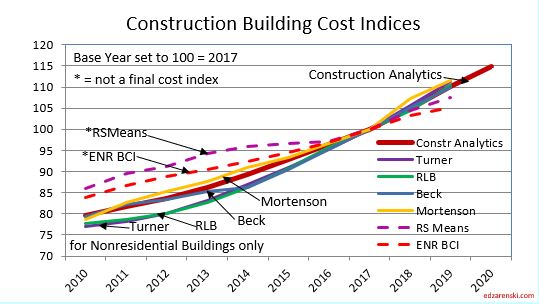
Non-building infrastructure indices are so unique to the type of work that individual specific infrastructure indices must be used to adjust cost of work. The FHWA highway index increased 17% from 2010 to 2014, stayed flat from 2015-2017, then increased 15% in 2018-2019. The IHS Pipeline and LNG indices increased 4% in 2019 but are still down 18% since 2014. Coal, gas, and wind power generation indices have gone up only 5% total since 2014. Refineries and petrochemical facilities dropped 10% from 2014 to 2016 but regained all of that by 2019. BurRec inflation for pumping plants and pipelines has averaged 2.5%/yr since 2011 and 3%/yr the last 3 years.
Anticipate 3% to 4% inflation for 2020 with the potential to go higher in rapidly expanding Infrastructure markets, such as pipeline or highway. This link refers to Infrastructure Indices.
Construction Analytics Building Cost Index

In the following plot, Construction Analytics Building Cost Index annual percent change for nonresidential buildings is plotted as a line against a bar chart of the range of all other nonresidential building inflation indices. Bars represent the predicted range of inflation from various sources with the solid line showing the composite final cost inflation. Note that although 2015 and 2016 have a low end of predicted inflation of less than 1%, the actual inflation is following a pattern of growth above 4%. The low end of the predicted range is almost always established by input costs (ENR BCI is plotted), while the upper end of the range and the actual cost are established by selling price indices.
Construction Analytics Nonresidential Buildings Cost Index
vs Range of Input Indices

As noted above, some reliable nonresidential selling price indexes have been over 4% since 2014. Currently most selling price indices are over 5% inflation since 2018.

Every index as published has its own base year = 100, generally the year the index was first created, and they all vary. All indices here are converted to the same base year, 2017 = 100, for ease of comparison. No data is changed from the original published indices.

Non-building Infrastructure indices are far more market specific than any other type of index. Reference specific Infrastructure indices rather than any average.
A word about terminology: Inflation vs Escalation. These two words, Inflation and Escalation, both refer to the change in cost over time. However escalation is the term most often used in a construction cost estimate to represent anticipated future change, while more often the record of past cost changes is referred to as inflation. Keep it simple in discussions. No need to argue over the terminology, although this graphic might represent how most owners and estimators reference these two terms.

This link points to comprehensive coverage of the topic inflation and is recommended reading. Click Here for Link to a 20-year Table of 25 Indices
Current$ vs Constant$ – Spending vs Volume
Comparing current $ spending to previous year spending does not give any indication if business volume is increasing. The inflation factor is missing. If spending is increasing at 5%/year at a time when inflation is 4%/year, real volume is increasing by only 1%.
Nonresidential buildings spending increased 3.3% in 2017, 4.4% in 2018 and 0.3% in 2019. But nonresidential buildings inflation for those three years was 3.7%, 5.0% and 5.0%. Nonresidential volume therefore declined for three consecutive years by a total of 5.5%. The current nonresidential buildings forecast spending growth is 3%/yr or less for the next three years. With inflation near 4%, that would suggest inflation adjusted nonresidential buildings construction volume is declining.
Residential spending increased from 2011 through 2017 by average growth of 13%/year. With average residential inflation during that period of 5%/year, inflation adjusted residential volume increased by 8%/year. That changed in 2018.
Residential spending increased only 2.7% in 2018 and dropped 4.6% in 2019. Residential inflation for 2018 and 2019 was 4.3% and 3.6%. Residential volume therefore declined by 1.6% in 2018 and 8% in 2019. Current residential forecast spending growth is +6% in 2020 but then -3.7% in 2021. With inflation just under 4%, that indicates inflation adjusted residential construction volume will grow only 2% in 2020 but may drop 7% in 2021.
In 2018 and 2019, total construction volume declined 6%. Residential volume declined 10%. Construction spending forecast for 2020 is $1,365 billion, an increase of 4.6% from 2019. But 2020 inflation is forecast at 4%. So, after inflation real volume growth in 2020 is forecast up less than 1%. It’s down 1.4% for nonresidential buildings but up 2% for residential.

Nonresidential Buildings will post declines in volume in 2020 & 2021. Non-building Infrastructure volume will increase 1% in 2020 and 4% in 2021. If residential starts hold as forecast at only 1% to 2% growth, residential volume will decline sharply by 7% in 2021 after a moderate 2% gain in 2020. Overall, total construction volume has declined in 4 out of the last 6 quarters and is forecast to drop slightly in 3 of 4 quarters in 2020.
The plot below, comparing inflation adjusted constant dollars with current spending dollars for all construction, clearly shows that although spending is at an all-time high, volume is down the last two years and is lower than all years from 1998 through 2008.
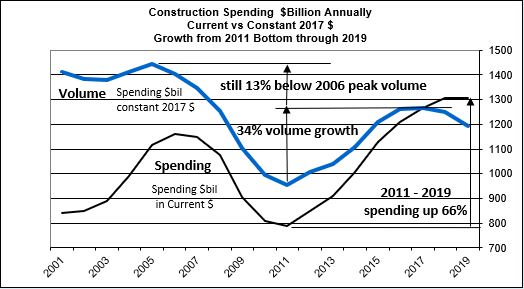
Spending after adjusting for inflation shows volume never got closer than 13% less than the previous 2005 high. Currently, volume is 17% lower than the 2005 peak.
Jobs and Volume
Construction requires about 5,000 workers for a year for every added $1 billion in construction “volume”. But construction jobs growth seems to closely follow growth in spending. Construction jobs have increased by 400,000 in a year only four times in the last 50 years, each time accompanied by one of the four highest spending growth increases in 50 years. However, spending is not the same as volume, and jobs needed is based on volume.
Construction added 1,400,000 jobs in the 5 years 2014-2018, an average of 280,000 jobs/year. The only time in history that exceeded jobs growth like that was the period 1993-99 with the highest 5-year growth ever of 1,483,000 jobs. That same 1993-99 period had the previous highest 5-year spending and volume growth going back to 1984-88.
Although 2020 spending will increase 4.6%, construction inflation has been hovering between 4% and 5% for the last five years. Real volume growth in 2020 after inflation is expected to be only 0.6% or only $7 billion. That would mean the need, if there are no changes in productivity, is to add only about 35,000 additional jobs in 2020.
But the results are much different for Residential than Nonresidential.
Nonresidential spending increased 50% since Jan. 2011 with 35% inflation. Nonresidential volume increased by only 15%. Jobs increased by 27%, 12% in excess of volume growth.
Residential spending increased by 125% since Jan. 2011, but after 40% inflation, real residential volume increased by 85%. Jobs increased by only 40%, 45% short of volume growth.
There are a few reasons why residential construction labor might not be compared easily to residential spending;
- Some residential high-rise jobs, for example structure, are performed by firms whose primary activity is commercial construction. Those jobs are classified as nonresidential.
- Buildings that are multi-use commercial retail and residential, even lo-rise, may be built by contractors whose firms are classified nonresidential labor. The construction spending would be broken out to residential and nonresidential, but the labor would not.
- Some undocumented labor is not counted, and it’s primarily residential.
For these reasons, it is best to simplify comparisons of spending activity to total labor.
Jobs should follow volume growth, yet history shows that in non-recessionary periods, even with volume declining, jobs usually continue to increase, but perhaps at a slower rate.
From 1997 to 2004, it took 4800 jobs to put-in-place $1 billion of construction in one year. By 2008 that increased to 5500 jobs to do $1 billion of work in one year. It remained level at 5500jobs/$1 billion/yr until 2016. In 2018 it jumped to 5800 jobs and in 2019, 6100 jobs, the highest ever recorded.
There has not been any volume growth in the last two years to support jobs growth. In constant$, there was no volume growth in any sector in 2018. In 2019 only Non-building Infrastructure shows 2% growth. Total construction volume is down 1.4% in 2018 and 4.4% in 2019.
In the last two years, spending increased only 2.5%, but construction inflation totaled 9%, therefore, real volume declined by more than 6%, yet jobs increased by 7.5%. From 2006 to 2017, jobs and volume growth were nearly equal. Since 2017, volume and jobs growth is diverging. Construction volume has been declining while jobs have been increasing. That can’t be sustained.
This plot shows predicted 2020 jobs growth of 1.5% or just over 100,000 jobs. Since volume is forecast to gain less than 1%, any jobs growth in 2020 beyond 1% will increase the disparity between jobs and volume growth. The disparity has been increasing since early 2018. It’s a 15% difference right now. Within a year that could be 20%.

By resetting the baseline of this next plot to 2006, the year of the last major divergence in jobs growth vs volume, it shows all other years from 2007 to 2017 were pretty well-balanced growth. With the exception of 2006 and now 2018-2019, for almost every year from 1997 to 2019 jobs grew pretty closely aligned with volume. A big 15% spread occurred in 2006, then growth remained balanced through 2017. The spread now is near the same as it was in 2006.
See post for development of this plot Expect Construction Jobs Growth to Slow in 2020

Volume declines will drive jobs to slower growth. We had 6 years of annual growth of 250,000-300,000/yr. Jobs increased by only 150,000 in 2019. In 2020, growth may be lower to 100,000.
Construction jobs growth slowed substantially the last two quarters. I predicted jobs growth would slow because volume growth had already been declining since early 2018 when volume reached a peak of $1,300 billion. Volume is now $1,200 billion, down 8% in 22 months. After 6 years of jobs increasing at an average 280,000/year, jobs are up only about +150,000 in 2019, but only +70,000 in the last 8 months. The rate of jobs growth is now the slowest in 7 years. I expect this trend to continue.
Volume declines should lead to lower inflation as firms compete for fewer new projects. However, if jobs growth continues while volume declines, then productivity continues to decline and that labor cost growth will add to inflation.

The plot of jobs growth shows current growth rate is below an annual rate of 150,000 jobs/year and it is expected to remain there through 2020, potentially dipping as low as 100,000.
I’d be surprised if jobs start to decline, but that certainly could be envisioned and it would help explain away some of the disparity in growth shown on the Jobs/Volume plot up above.
Predicted Reliability of Construction Forecasting
For any future forecast month, the most information is in hand the month before. Assessing the amount of actual data (jobs in backlog) versus the amount of predicted data gives an indication of how much weight can be placed on the forecast. Obviously, the balance of actual data versus predicted data gets less the further out in time we view the forecast.
For Nonresidential work, most of the spending in any given year comes from projects already in backlog. For nonresidential forecasting, 80% of all the spending in the year comes from projects in backlog. Only 20% of spending in the year is generated from new project starts within the year.
For Residential work, most of the spending in any given year comes from new project starts within the year. Only about 30% of the spending in the year comes from projects already in backlog.
The total amount of work in backlog supports 98% of the forecast in the following month for nonresidential and 94% of the forecast for residential. The amount of known work that will generate spending in the month 12 months out from the forecast date is only 80% for nonresidential work. It’s only 30% for residential work.
For the period only 12 to 24 months out from the forecast date, actual nonresidential data drops from 80% to 30%. Residential actual data drops from 30% to zero.
For all markets combined, accounting for the weighted averages of residential and nonresidential work, once all construction starts are reported to include the data as of Dec. 2019, the 2020 forecast includes 78% actual data and 22% predicted data. The 2021 forecast includes only 40% actual data from starts that have been booked. All the rest of the 2021 forecast is predicted.
Three years out from the current date the reliability of the forecast is dependent entirely on economic outlook and the predictive methodology of the analytic tools, not on actual data. It’s important to know, when you are looking at a forecast that projects three years out past the current year, there may be no “actual” data in that forecast.

Questions regarding this analysis can be addressed to: Edward R. Zarenski – Construction Economics Analyst – Construction Analytics – edzarenski@gmail.com – 401-330-6152
Data used in this report is accessed from the following data sources:
Construction Analytics Economics Reports https://edzarenski.com/
Construction Analytics Inflation https://edzarenski.com/2016/10/24/construction-inflation-index-tables-e08-19/
Associated General Contractors of America AGC https://www.agc.org/learn/construction-data/construction-data-producer-prices-and-employment-costs
Dodge Data and Analytics Construction Starts https://www.construction.com/news
Engineering News Record https://www.enr.com/
Mortenson https://www.mortenson.com/cost-index
Rider Levitt Bucknall https://www.rlb.com/en/index/publications/?geolocation=americas
RSMeans data from Gordian https://www.rsmeans.com/landing-pages/2019-rsmeans-cost-index.aspx
S&P/Case-Shiller U.S. National Home Price Index https://fred.stlouisfed.org/series/CSUSHPINSA
Turner http://www.turnerconstruction.com/cost-index
U.S. Census Construction Spending https://www.census.gov/construction/c30/release.html
U.S. Census Housing Construction Index https://www.census.gov/construction/nrs/pdf/price_uc.pdf
U.S. Department of Labor Bureau of Labor Statistics https://www.bls.gov/ppi/ppinrbc.htm
U.S. Department of Labor Bureau of Labor Statistics Construction Labor U. S. https://www.bls.gov/iag/tgs/iag23.htm
Click here for a downloadable PDF of 2020 Construction Economic Forecast Feb 2020
Click here for a downloadable PDF of SUMMARY – 2020 Construct Econ Forecast 2020
2020 Construction Forecast Briefs
2020 Construction Forecast Briefs
12-23-19 updated 1-4-20
updated 1-4-20 – The construction spending forecast for 2019 is revised up to $1,304 billion, still a decrease of 0.2% vs 2018. Almost all of the revision up is residential spending that was added in Oct and Sept Census spending revisions released 1-3-20.
The forecast for 2020 construction spending is $1,360 billion, up 4.5% over 2019.
Total Spending increased 9%/yr. from 2012 to 2016, then in 2017 and 2018 slowed to 4%/yr. Spending declined <1% in 2019 and is forecast up 3% to 4% for both 2020 and 2021.
New construction starts, as reported by Dodge Data and Analytics, increased 7%/year in 2016 and 2017, but only 3% in 2018. Starts are forecast to decline slightly in 2019 and 2020.
New construction starts data captures a share of the total market or a portion of all construction spending, on average about 60% of all construction. In this analysis every market is adjusted by its own individual market share factor.
Applying the market share factors, starts are forecast up slightly in both 2019 and 2020.
Backlog reaches a post-recession high starting 2020, up 20% from 2017, up 100% from 2013. Starts and backlog growth are forecast to remain below 3%/year gain or decline over the next few years. Total spending has only slight gains in 2021 and 2022.
Backlog at the beginning of the year or new starts within the year does not give an indication of what spending will be like within the year. Backlog increases if new starts during the year is greater than spending during the year. An increase in backlog could be a level rate of market activity for a longer duration. It takes several years for all the starts in a year to be completed. Cash flow shows the spending over time.
The best indicator of future construction activity is the sum of the projected cash flow generated by all the construction starts that have been recorded.
plots updated 1-4-20
Spending cash flow predicted from Dodge Starts and construction spending to date.

A what if scenario in which new construction starts drop by 10%:
On average about 20% of new nonresidential construction starts gets spent within the year started, 50% is spent in the next year and 30% is spent in future years. (For residential the spending curve is more like 70%-30%). If new starts drop by 10% this year, that has only a -2% impact on total nonresidential buildings spending for this year. It would be -5% next year, -3% after. If starts drop a second year, the same impacts occur, shifted one year out, and the total impact for both years is added.
Only about 30% of residential spending within the year comes from backlog and 70% from new starts. If residential new starts drop 10% that impacts total residential spending by 7% in that year.
Nonresidential Buildings starts (excluding Terminals) have reached a new high every year since 2009, but the last three years starts are up only 2% to 3%/year. Every market posted increases in 2017 and 2018. Only Commercial/Retail and Amusement/Recreation declined in 2019. Backlog for Office Buildings, which includes data centers, is up 100%+ since 2015. Spending is still up 4% in 2020 but then with the slowdown in starts forecast in 2020, backlog growth stalls and spending slows in 2021-2022.
Nonresidential buildings markets advancing in 2020-2021 are Educational, Healthcare, Office and Manufacturing. Markets declining are Amusement/Recreation, Commercial/Retail and Lodging.
Non-building Infrastructure starts (including Terminals), up 4% in 2019, are at an all-time high. The two markets with the largest share of new starts are Highway/Bridge and Transportation. Transportation terminals and rail starts are up 30% in the last three years, but backlog has nearly doubled because a large portion of those starts is very long duration projects. Starts are forecast up only 1% in 2020 but backlog peaks in 2021. Spending increases are in the 6% to 8% range at least for the next two years.
Spending in recent years has been boosted by Transportation terminals, Highway and Public Works projects. Power is flat or down slightly.
Residential starts averaged 19%/year growth from 2012 to 2016 but slowed to 5%/year for 2017 and 2018. Starts declined in 2019 and are forecast to decline again in 2020.
The outlook for residential construction spending has improved slightly. Previous forecast had residential spending in 2019 down 6% and 2020 up only 2%. That’s been revised to now forecast 2019 down 4.5% and 2020 up 5%. Spending holds steady in 2021.
If spending is increasing 3%/year at a time when inflation is 5%/year, then real volume is declining. In the last two years, spending increased only 3%, but construction inflation totaled 9%, therefore
in two years, real volume declined by 6%, yet jobs increased by 7.5%.
Since early 2018, jobs have been increasing while construction volume is declining. The volume of work in the last two years does not support jobs growth.
Volume, spending adjusted for inflation in Constant 2017$

Nonresidential Buildings will post declines in volume in 2020 & 2021. Residential volume gains 1% in 2020 but slips again in 2021. Non-building Infrastructure will increase volume about 3%/year. Overall, total construction volume declined in 4 of the last 6 quarters and is forecast to drop slightly in 2 or 3 quarters in 2020.
One of the best predictors of construction inflation is the level of activity in an area. When the activity level is low, contractors are all competing for a smaller amount of work and therefore they may reduce margins in bids. When activity is high, there is a greater opportunity to bid on more work and bids can be higher. The level of activity has a direct impact on inflation.
Volume declines should lead to lower inflation as firms compete for fewer new projects. However, if jobs growth continues while volume declines, then productivity continues to decline and that will add to labor cost inflation.
Jobs vs Volume growth set to base year 2011

Average long-term nonresidential buildings inflation excluding recession years is 4.2%.
Average long-term (30 years) nonresidential construction cost inflation is 3.5% even with any/all recession years included.
Nonresidential buildings cost inflation for 2018 and 2019 averaged 5%. It’s predicted closer to 4.5% for 2020 and 4% for 2021.
Residential buildings cost inflation for 2018 and 2019 averaged 4%. It’s predicted at 3.75% for 2020 and 2021.

For more on the 2020 Forecast see these
Construction Starts > Cashflow > Backlog > Spending
The path from construction starts to spending is not direct and not quite as simple as you might think. Spending is the market activity measure that drives all construction economics, so that’s where we need to get too. With an appropriate modeling technique we can get from new starts to predicted spending in a few steps.
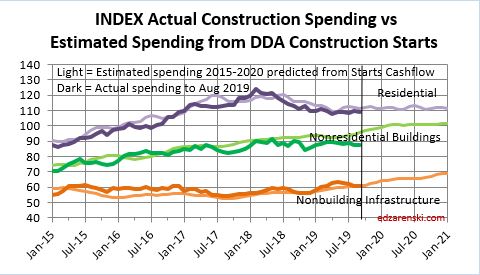
New Construction Starts (construction starts referred to here is Dodge Data & Analytics New Construction Starts) is excellent data for forecasting. The following forecast is entirely developed from starts data. No actual spending is incorporated into this forecast. The purpose is to show that using the data properly can produce an accurate forecast.
The starts data is a survey. As in any survey, starts represents a portion of new construction activity. Study shows the survey size varies with each market from about 40% to 70% of actual. Starts data captures a share of the total market or a portion of all construction, on average about 60% of all construction.
The easiest way to understand this is to compare total annual construction starts to total annual spending. National construction starts from 2016 to 2019 range from $750 billion/year to $800 billion/year, while spending in this period ranges from $1,200 billion/year to $1,300 billion/year. From this we see starts data captures a share of about 60% of the total construction market.
The total starts survey averages about 60% of the actual market. In this analysis every market is adjusted by its own individual market share factor. The adjusted starts represent the full amount of starts that would generate the full amount of spending.
To predict spending activity from new construction starts, the starts data must be spread over time using appropriate cash flow curves. On average about 20% of new construction starts gets spent within the year started, 50% is spent in the next year and 30% is spent in years three and four. The cash flow curves used in this model are specific to each market type and can vary from the average.
Applying a market survey factor to develop full magnitude of spending and an expected duration for all starts, depending on market type, to produce a forecast cash flow from starts data, the predicted pattern of spending is developed. The factors have been shown to produce a reliable prediction of total future market activity.

Backlog at the beginning of the year or new starts within the year does not give an indication of spending within the year. New starts within the year could contribute spending spread out over several years. Total cash flow in the year, or spending, could include cash flow from projects that started or entered backlog years ago.
Backlog increases if new starts during the year is greater than spending during the year. However, an increase in backlog does not necessarily indicate there will be an increase in market activity. An increase in backlog could represent a level rate of market activity, but for a longer duration.
Cash flow provides the best indicator of how much and when spending will occur. Cash flow from all previous starts gives a prediction of how spending will change monthly from all projects in backlog. Cash flow totals of all jobs can vary considerably from month to month, are not only driven by new jobs starting but also old jobs ending, and are heavily dependent on the type, size and duration of jobs.
Total of all national construction starts increased every year since 2008. New starts slowed to +2% in 2018 and are forecast at a potential decline of 0.2% in 2019. Backlog is still up leading into 2020 but after that starts and backlog are forecast to remain flat or decline over the next few years. Total spending declines in 2022. However, as the next tables will show, work distribution is uneven with residential declining and nonresidential up.

Nonresidential Buildings starts (excluding Terminals) reached a new high every year since 2009. The last three years starts are up 3% to 4% per year. Every market posted increases in 2017 and 2018. Only Commercial/Retail declined in 2019. The largest increases over the last two years were Educational and Office Buildings. Spending is still strong in 2020 but then with the slowdown in starts forecast in 2020, backlog growth stalls and spending slows in 2021-2022.
75%-80% of all Nonresidential Buildings spending within the year will be generated from projects that were booked in starting backlog at the beginning of the year.

Nonbuilding Infrastructure markets total spending amounts to only about 70% of nonresidential buildings markets. The largest infrastructure markets are Highway/Bridge and Power but the largest increases in new starts recently are in Transportation (including all terminals) and Environmental Public Works. Transportation starts are up 25% in the last last three years and backlog to start 2020 is up 80%. Public Works starts are up 22% and backlog is up 30%
Nonbuilding Infrastructure starts can be erratic with a long pattern of up then down years. Starts (including Terminals) gained only 2% in 2019 but that is only low because Power, the largest market overall saw starts decline by 7%. Total infrastructure starts are at an all-time high.

Infrastructure backlog peaks in 2020 and remains high into 2021. Spending increases are in the 6% to 8% range at least for the next two years. Infrastructure projects typically have the longest duration. Projects contribute spending sometimes up to 5 or 6 years. The largest spending increases in 2020 are in Transportation and Highway projects.
The Residential table shows that most of the spending in any year is cash flow from new starts. For short duration residential spending, single-family residential and renovations work, approximately 75% of the spending occurs in the year of the starts and 20% in the following year.

For long duration residential spending, typical of multifamily residential, approximately 50%-55% of the spending occurs in the year of the start, 35%-40% in the next year and only 5%-10% occurs two years out.
Only 25% (for short duration SF and Reno) to 50% (for longer duration MF) residential spending within the year comes from work that was booked in backlog at the beginning of the year. The performance of residential spending in the year is very much dependent on new starts.
The level of activity has a direct impact on inflation. When the activity level is low, contractors are all competing for a smaller amount of work and therefore they may reduce bids. When activity is high, there is a greater opportunity to bid on more work and bids can be higher.
Residential construction saw a slowdown in inflation to only +3.5% in 2015. However, the average inflation for six years from 2013 to 2018 was 5.5%. It peaked at 8% in 2013. Residential construction spending dropped an unexpected 6% in 2019 and after adjusting for inflation that is a 10% decline in construction volume. Typically, large declines in volume are accompanied by declines in inflation. National average residential construction inflation for 2019 is now at 3.8%. 2020 is forecast at 3.75%.
Nonresidential Buildings indices have averaged 4.4% over the last five years and have reached over 5% in the last three years. But spending slowed dramatically in 2019. This forecast indicates spending in most nonresidential buildings markets will gain little in 2019, the slowest rate of growth post-recession. However, new starts in 2018 and 2019 boosted backlog and 2020 spending will post the strongest gains in four years. Strong gains in spending historically has led to accelerated inflation. National average nonresidential buildings construction inflation for 2019 is now at 4.8%. 2020 is forecast at 4.2%.
Prelim 2019-2020 Construction Spending
Note 11-8-19 on September spending: Construction Spending in September is up 0.5% from August and still down 2.2% year-to-date (ytd) from 2018. Spending in Q3 averaged the same as Q1. Qtr/Qtr spending this year has ranged +/- 1%. Total 2019 spending will be down 1%. I’m expecting 2019 Nonresidential Buildings spending up less than 1%, Non-building Infrastructure up 7% and Residential spending down 6%.
10-3-19
Construction Spending in August is down slightly from July and down 2.3% year-to-date (ytd) from 2018. Spending for the last three months has remained flat. Qtr/Qtr spending has ranged +/- 2% for the last five quarters. Total 2019 spending will be down 0.5%. I’m expecting 2019 Nonresidential Buildings spending up 1%, Non-building Infrastructure up 8% and Residential spending down 6%.
Residential construction spending, down for six consecutive quarters, is now down 11% from Q1 2018. Residential volume (spending minus inflation), also down for six quarters, is down 16% from the Q1 2018 peak.
Some markets spending totals for 2019: Lodging +11%, Office +10%, Amusement and Healthcare both +5%, Commercial/Retail -14%, Highway +11%, Power +7%, Transportation +6%, Environmental Public Works (combined) +12%.
2020 forecast Starting Backlog for Nonresidential Buildings is currently up 6% and for Non-building Infrastructure is up 9%. Strong backlog leading into 2020 will increase spending in most nonresidential markets. Exceptions are: Commercial/Retail and Power backlog will decline. Residential spending is 65% dependent on new starts but Nonresidential spending is 80% dependent on backlog.

Forecast growth for 2020 is welcome since real construction volume, after accounting for 4% to 5% inflation, has been down for five of the last six quarters. Annual construction inflation since 2011 has been as high as 5.8%. For the last 3 yrs it has averaged 4.6%/yr. Construction spending for the last 3 years avg. annual growth is only 2.4%. When construction spending is lower than inflation, real volume is declining. Jobs must be compared to volume.
Total construction volume after inflation (quarterly avg) reached a peak in the 1st quarter of 2017 (which was then matched again in Q1 2018) and is now down 6% from the peak. Most of the volume decline was in Residential. Only Infrastructure has seen volume gains in the last two years. We have seen jobs growth slow in the last year, but the disparity between construction volume and jobs growth is the greatest ever. I expect to see a much more significant slow down in jobs growth.

Backlog growth over the past two years will provide the base for Nonresidential construction spending increases in 2020. Major backlog increases from 2018 to the start of 2020 are: Educational +12%, Office +25%, Commercial/Retail -14%, Highway +16%, Transportation +45% and Environmental +23%.
The forecast for 2020 spending is total $ up 3%, but Residential spending will be flat to down slightly.
Construction Spending Forecast strength over the next 18 months is all nonresidential. Current spending seasonally adjusted annual rate (SAAR) vs SAAR at the end 2020 shows Nonresidential Buildings now at $450bil will end 2020 at $500bil and Non-building Infrastructure, now at $340 billion, will end 2020 at $375bil. Residential is now at $510bil but will move up slightly then down to finish 2020 at $500bil.

SEE ALSO:
Spending Revisions 9-3-19. Nonresidential Increases. Residential Slows.
Midyear 2019 Construction Spending Forecasts Compared
WHAT IF? Construction Recession 2020
8-15-19
Talk these days isn’t whether or not we may slip into another recession, but when. Analysts are watching for signals. On any given day you can read articles pointing to why we are or why we are not headed into another recession. But, I wrote an article similar to this 3 years ago, so that opinion has been around awhile. I’m not taking a position here. I would just like to get a rough idea of implications, so I tested some data.
What would happen to this current construction recovery if we slip into recession?
If you think of a recession as having an immediate affect on total construction, like a quick drop in materials prices or cost of buildings, think again. Construction is sort of like an aircraft carrier, it takes a long time to turn around.
My starting baseline is my current construction spending and backlog forecast for 2019-2020 which includes YTD Spending and Starts through June. All spending and starts are current$, unadjusted for inflation. There is considerable strength in Nonresidential Buildings and Non-building Infrastructure starts and spending. There is weakness in residential.
NORMAL FORECAST current to Jul 2019 with no modifications

NORMAL FORECAST spending plots for the next 18 months.

Recession What If? Starting Point
The best indicator of future construction activity is the projected cash flow generated by all the construction starts that have been recorded. Construction starts mark the beginning of spending on new projects. Projects can take many months to reach completion, and the cash flow varies over the project time.
For the 2020 forecast, we can look at new starts and backlog.
Construction Starts YTD total as of June is down 8% from 2018. That’s expected to improve by year end.
Residential construction starts peaked in 2018. Starts have been sideways or in light decline since mid-2018. Year-to-date June 2019 starts are down 9% from 2018. Avg SAAR for 1st 6mo 2019 is $315bil, same 6mo last year was $340bil. Starting backlog is down 5% from 2017 to 2019. Spending is forecast down 5% in 2019 and up only 1% in 2020.
Nonresidential Buildings starting backlog increased 10%/year for the 4 years 2017-2020. Prior to this recession scenario analysis, nonresidential buildings spending was forecast up 10% in 2020 and 6% in 2021.
Infrastructure starting backlog has increased 15%/year for the 3 years 2018-2020. Prior to this recession scenario analysis, non-building infrastructure spending was forecast up 12% in 2020 and 8% in 2021.
For nonresidential buildings, 80% of all spending in any given year is already in backlog from starts prior to that year. For non-building infrastructure it’s 85%. Starting Jan. 1, 2020, 80% to 85% of all nonresidential spending in 2020 is already on record in backlog. For residential, only 30% of spending in 2020 is in backlog at the start of the year. Due to shorter duration, spending is more dependent on new starts within the year.
Backlog starting 2020 for the following six markets is at the highest starting backlog ever for each of the six markets. Also, these six markets account for 1/3rd of all construction spending. Much of the spending from these starts occurs in 2020.
These markets posted the best construction starts 12-month totals ever (in noted period).
- Manufacturing from Jun18>May19, up 36% in two years
- Office May18>Apr19, up 8%/yr for the last 4 years
- Educational Jun18>May19, monthly rate for 12 of the last 16 months increased by 20%.
- Public Works May18>Apr19, increased 30% in the last 24 months.
These very long duration markets posted best new starts ever.
- Highway Dec 17>Nov18, up 25% compared to prior 12 months, which was the 2nd best 12mo ever, with peak spending from those starts expected in 2020.
- Transportation (2yrs) Jan17>Dec18, up 25% from the prior 2 years, but with the peak 12 months up 35% from the prior 2 years, with peak spending 2020.
Growth in new starts and backlog for the last three years (2017-2018-2019):
- Manufacturing starts up 44%, backlog up 62%
- Office starts up 30%, backlog up 62%
- Highway starts up 45%, backlog up 70%;
- Transportation starts up 64%, backlog up 138%;
- Public Works new starts up 45%, backlog up 72%.
In the last two years, Commercial/Retail market starts are down 18% and 2020 starting backlog will be down 11%. The only other declines in 2020 starting backlog are Amusement/Recreation (-1%) and Power (-5%).
So, we are starting 2020 with the highest backlog on record after several years of elevated starts. However residential work is already down slightly while non-building infrastructure work is super-elevated. It is this elevated backlog that will mute the impact of a recessionary downturn.
What If? we reduce new starts
If a recession were to occur, it would substantially reduce future construction starts. Most, if not all, projects already started would move on to completion, but new starts will be cut back. However, the last “construction” recession started in 2006-2007 with declines in residential work. New starts in nonresidential buildings kept increasing into 2008. The “nonresidential” spending recession did not start until 2009, three years after the beginning of the residential decline.
To get an idea how another recession might affect construction spending, I kept all backlog growth predicted through 2019, but I reduced future new construction starts, for two years, starting Jan 2020. I’ve started the reductions for all sectors at Jan. 1, 2020 because residential starts and spending have already been in decline for more than a year.
- Residential starts reduced by 15% in 2020 and by 5% more in 2021
- Nonresidential buildings reduced by 20% in 2020 and by 10% more in 2021
- Infrastructure projects reduced by 10% in 2020 and by 5% more in 2021
This is only about 20% of the residential declines we experienced from 2006 to 2009, but I’m not anticipating another residential massacre. Residential has already been in decline for 12 months. The nonresidential buildings decline now is only half of 2008-2010. I reduced infrastructure by the least since there was only moderate decline in infrastructure work in 2009-2010, yet still I’ve reduced infrastructure twice as much as 2009-1010. I allowed for a 3% increase in new starts in 2022 across buildings sectors and a 2% increase in infrastructure.
The Recession Scenario Results
The recession 2020 scenario keeps 2019 forecast intact and reduces new starts by 15%-20% in 2020 and 5%-10% in 2021, so imparts a two year downturn. It’s effects, begun Jan.1, 2020 could be translated over time, if say the same scenario started but 12 months later. Negative reaction in the market is quickest to happen for residential, delayed a year for nonres buildings and takes longest (2 years) for infrastructure, for reasons of longest duration type work and highest prior rate of backlog growth.
The recession affects are muted by the fortunate starting point of record high backlog. Residential construction spending will experience two to three declining quarters each of the next three years. But beyond Jun 2022, residential stabilizes and resumes growth. Residential is the only sector to post quarterly spending declines in 2020. Nonresidential buildings posts the 1st quarterly decline in Q1 2021 and has at least seven consecutive quarters of declines before flattening out in Q4 2022. Non-building Infrastructure experiences the 1st two consecutive quarters of decline starting Q4 2021 and reaches a low in Q4 2022. Due to the unevenness of growth, Total Construction spending increases through Q1 2020, posts two declining quarters in 2020 and three consecutive quarters of declines in each of 2021 and 2022.
RECESSION FORECAST spending plots for the next 30 months.

Here’s a reminder of the amount of reductions in new starts. I kept all backlog growth predicted through 2019, but I reduced future new construction starts, starting Jan 2020. I’ve started the reductions for all sectors at Jan. 1, 2020 because residential starts and spending have already been in decline for more than a year.
- Residential starts reduced by 15% in 2020 and by 5% more in 2021
- Nonresidential buildings reduced by 20% in 2020 and by 10% more in 2021
- Infrastructure projects reduced by 10% in 2020 and by 5% more in 2021
We still see an 11% increase in backlog in 2020, because we did not reduce 2019 starts, but spending from reduced new starts in 2020 drops 2020 cash flow within the year to slow growth of 2%. Reference the baseline spending chart to see prior to reducing starts 2020 spending was forecast to increase 7%. Backlog drops 7% in 2021 and then 11% in 2022. This model predicts a 4% decline in construction spending in 2021 (baseline was +3%) and a 5% drop in 2022 (baseline was -1%), setting us back to the level 2016-2017.

Starting Backlog is down 4.4% for 2023, but even modest new starts growth of 3% helps partially offset the decline in spending. Spending never drops below the level posted in 2015-2016.
The last recession started with residential in 2005 and ended with nonresidential in 2011. Total decline during that period set total spending back 12 years, although the setback was 15 years for residential, 7 years for nonresidential buildings and only 4 years for infrastructure. This mild recession causes a setback to 2015-2016 levels, back 6 years, and less for infrastructure.
RECESSION FORECAST current to Jul 2019 with reduced starts 2020-2021

Residential construction would drop about 6% in 2020 and then drop another 8% in 2021. Residential is far more dependent on new starts within the year for spending than on backlog. That’s why residential spending drops quicker than all other work.

Nonresidential buildings gain 5% in 2020 but then drop 6% in 2021 and 12% in 2022. The strength of backlog going into 2020 pushes most of the declines out to 2021 and 2022.

Non-building Infrastructure has so much work in backlog that this sector still posts spending gains in 2020 and 2021. It drops 8% in 2022. The strength of backlog going into 2020 pushes much of the declines out 2022.

The baseline forecast would have produced spending increases of 9% from 2020-2022. The recession scenario indicates a 7% decline. That magnitude of turn around would impact the jobs situation. We would probably not see any reduction in workforce in 2020 but the spending declines in 2021 and 2022 could lead to a temporary loss of about 200,000 jobs in 2021 and 300,000 jobs in 2022.
Educational 2019 spending is supported by a steady stream of strong starts that began in late 2017 and extended into summer 2018. Jun-Jul-Aug 2018 starts posted the best 3mo total starts ever and peak spending from those starts occurs from April 2019 to Jan 2020. Most spending in 2020 comes from projects that start in the 1st half of 2019. So far in 2019 starts are up 15% ytd over 2018.
Commercial Both store and warehouse starts dropped in 2018. Commercial starts are seeing strong gains from distribution centers (warehouses, which are in commercial spending). Since 2015 the 10% decline in retail stores is being hidden by the 50% increase in warehouses, which are at an all-time high. Stores are down 10% from the peak in 2016. Warehouses are down 5% in 2018 but increased 500% from 2010 to 2017.
Manufacturing Backlog is still very strong, but a drop in peak spending from the schedule of cash flows will lead to a period of moderate spending declines. After that, manufacturing spending increases steadily through the end of 2020. Current expectations are that manufacturing will finish the year up 8%. 2020 will be an extremely strong growth year, spending potentially increasing 20%+. Reductions in starts won’t show up as negative spending until 2022.
Office spending is expected to finish 2019 up 7% or less. New starts in 2018 were up 11% to a new high, but much of the peak spending, from over-sized long-duration projects, will benefit 2020 when I expect to see spending growth of 8%-11%.
Transportation starts have two main parts, Terminals and Rail. Some analysts include transportation in nonresidential buildings. That does not consider the following: airports include not only land-side terminals but also air-side runway work; rail includes platforms and all railway right of way work, which includes massive civil engineering structures. About half of all transportation spending is rail work. Construction Analytics follows U S Census construction spending reports which include all terminals and rail in Transportation.
Terminals and rail starts reached record highs in 2017 and record backlog in 2019. 2019 starting backlog is four times what it was in 2015.
However, much of that backlog is very long duration project spending that will occur in future years. Some of the project starts in 2016 and 2017 have an eight-year duration. From Oct’16 through Oct’18 there were sixteen $billion+ new project starts and seven $500million+ new starts. Some projects started in this period have peak spending occurring in 2020 and 2021.
Highway/Street/Bridge starts hit an all-time high in 2018. Current 2019 progress shows new starts leveling off. Starting backlog increased 70% in the last 3 years leading into 2020. A lot of this is long duration backlog that will provide for large increases in spending in from 2019 to 2021.
Environmental Public Works (Sewage, Water supply and Conservation) new starts all declined from 2014 through 2017. Then all showed 14% gains in 2018 and the forecast is +15% in new starts in 2019.

